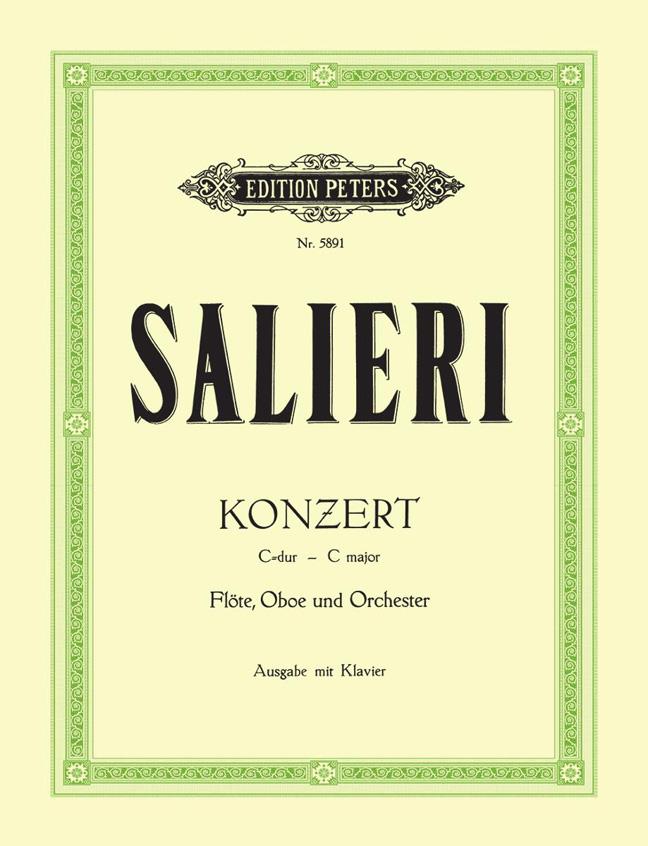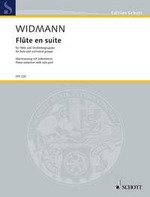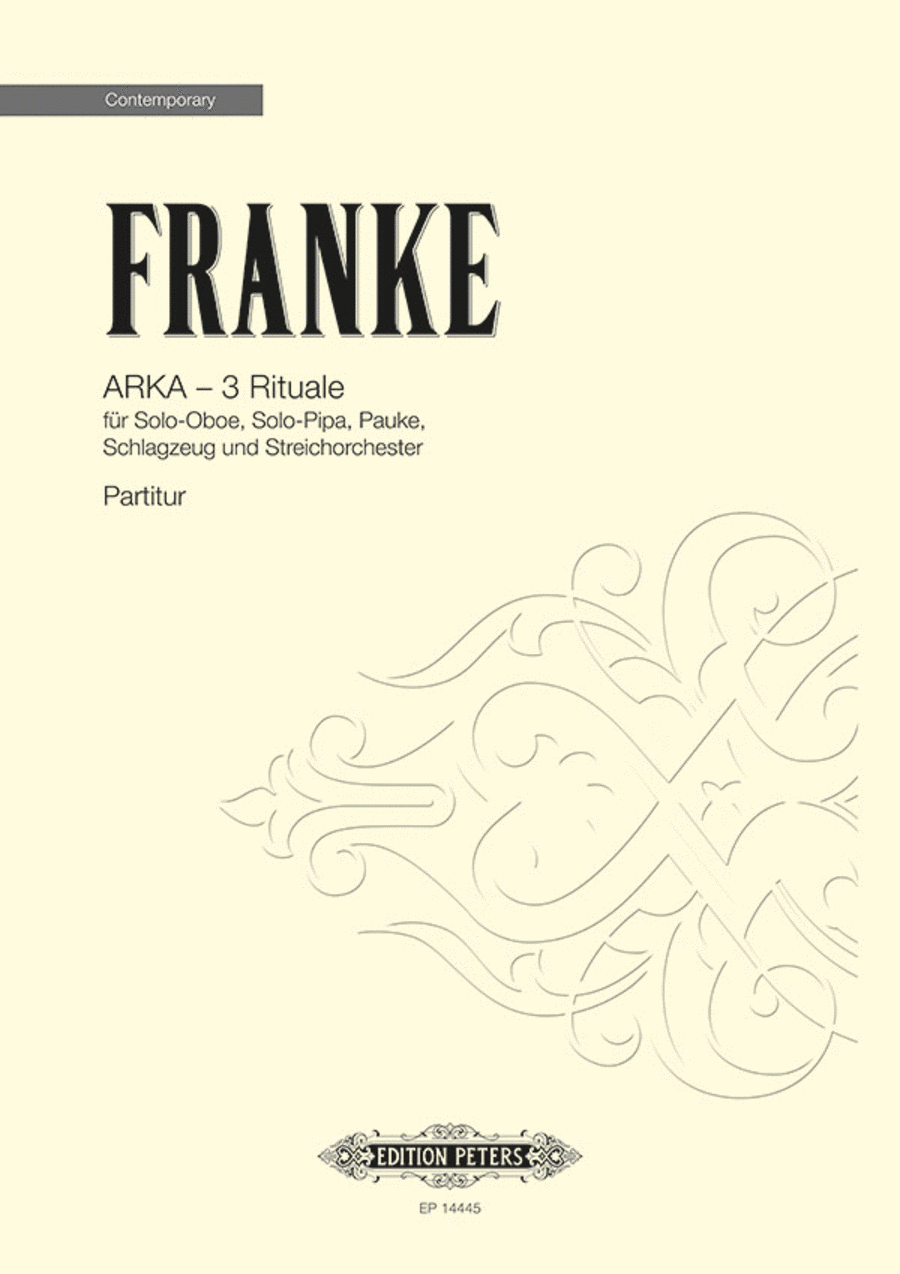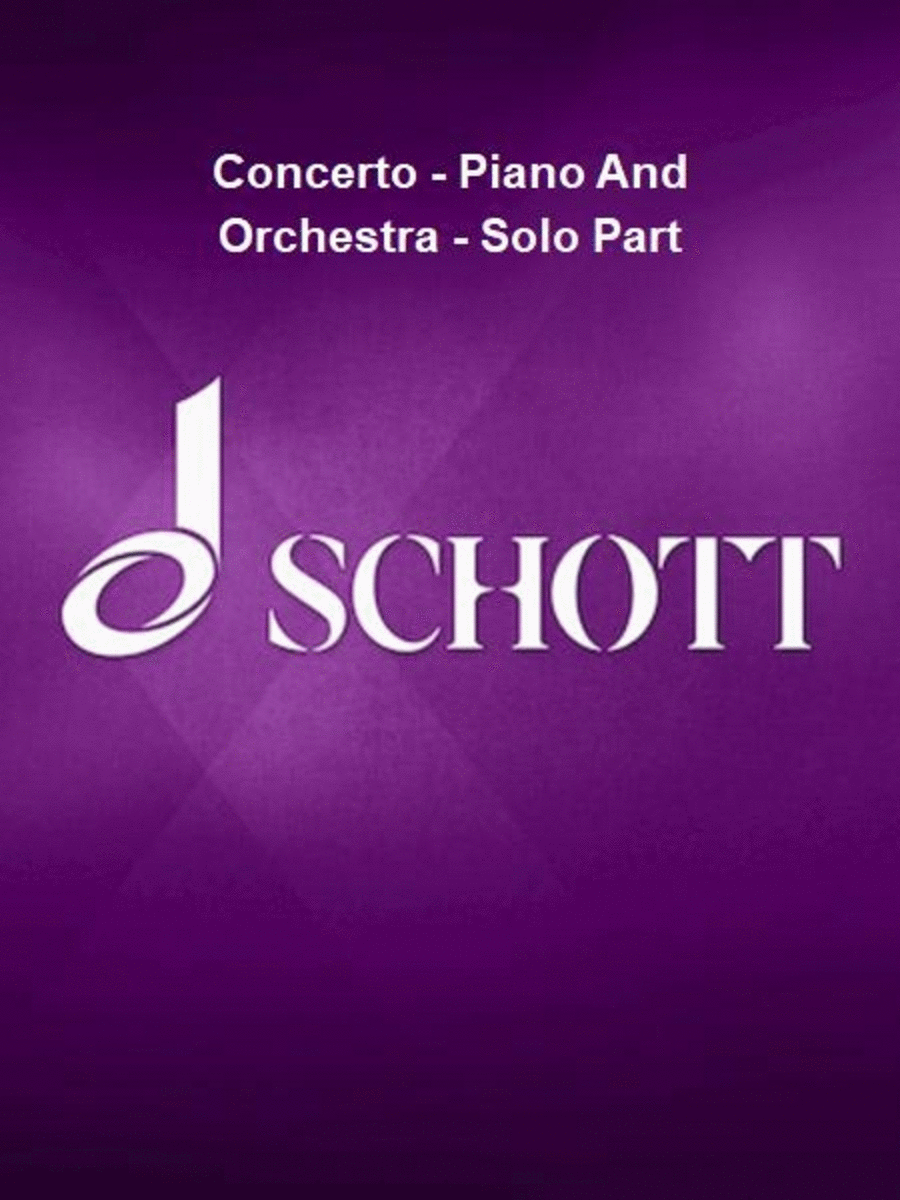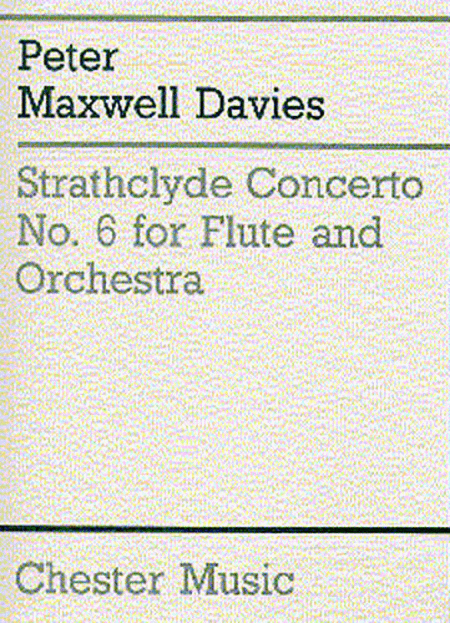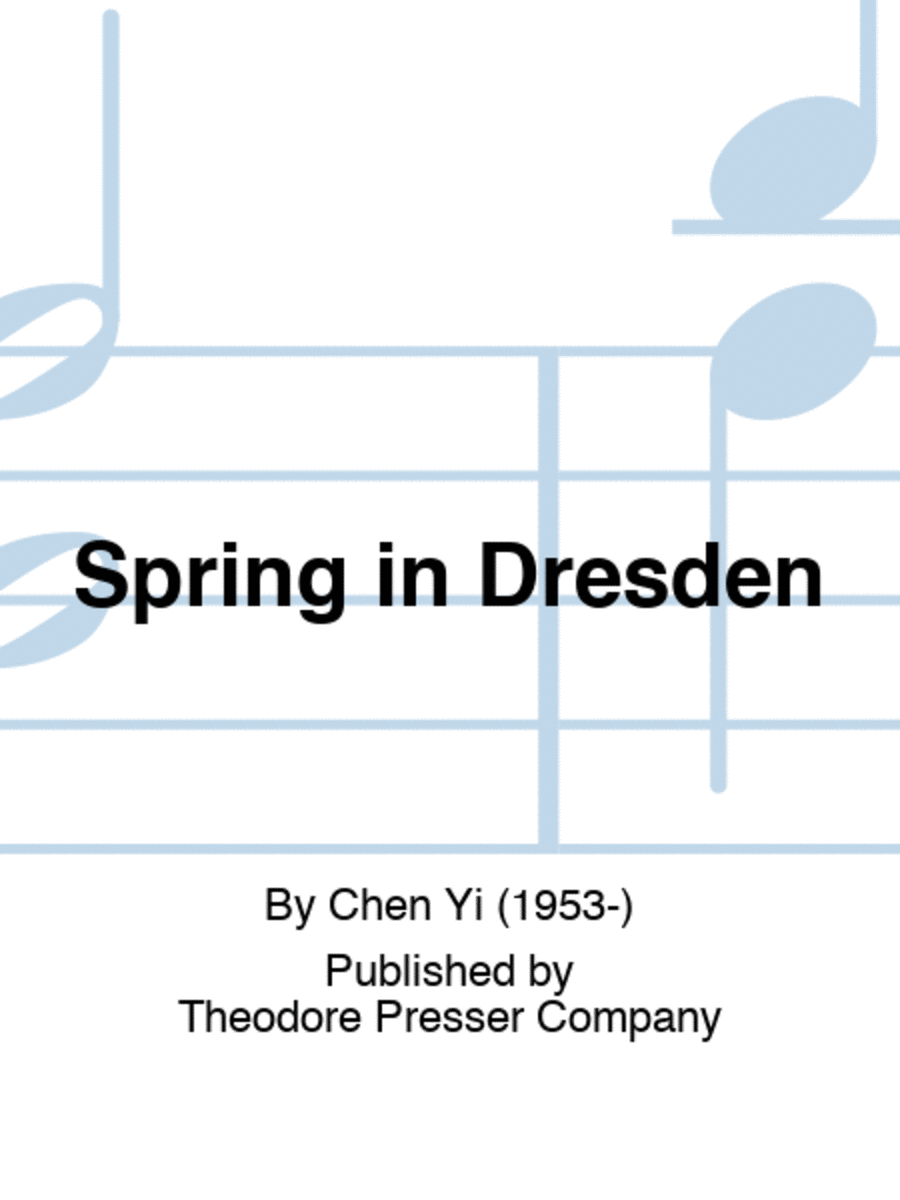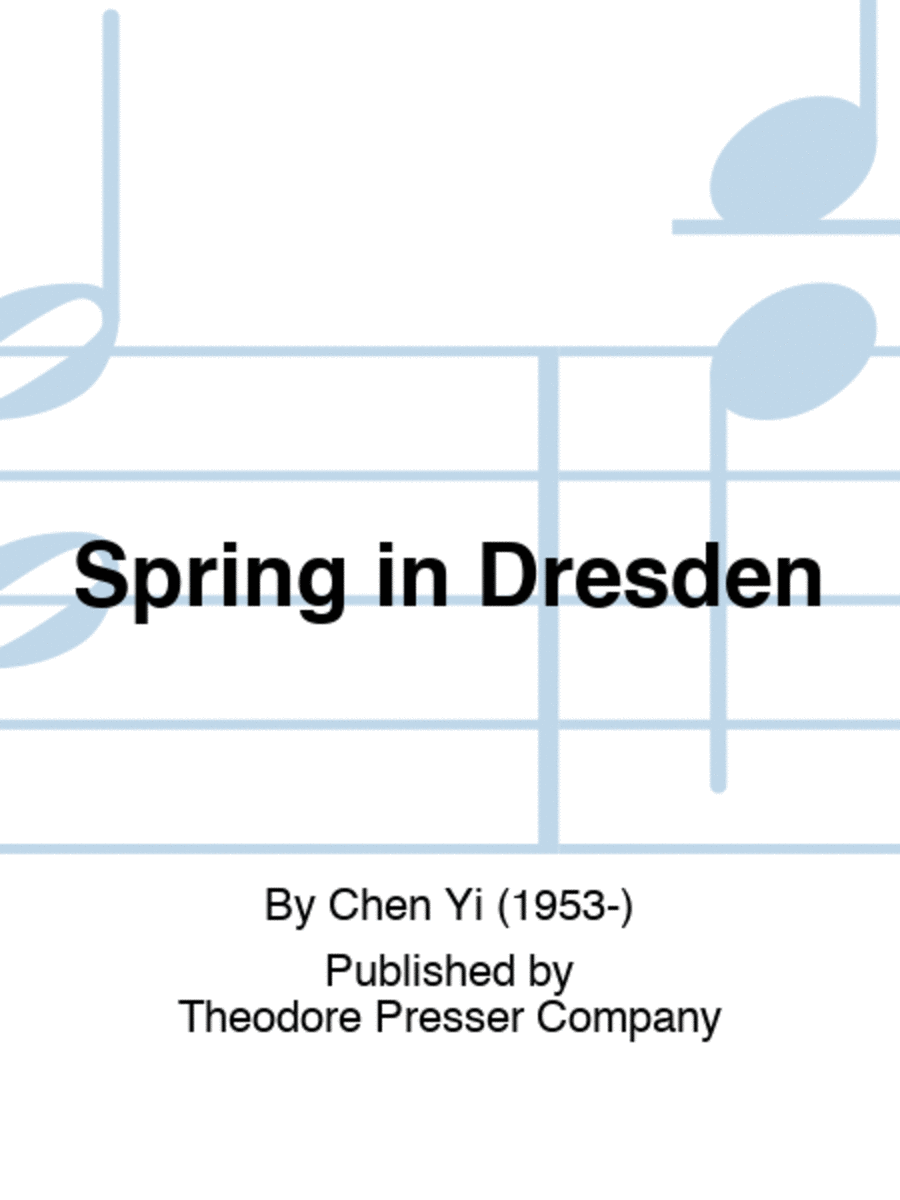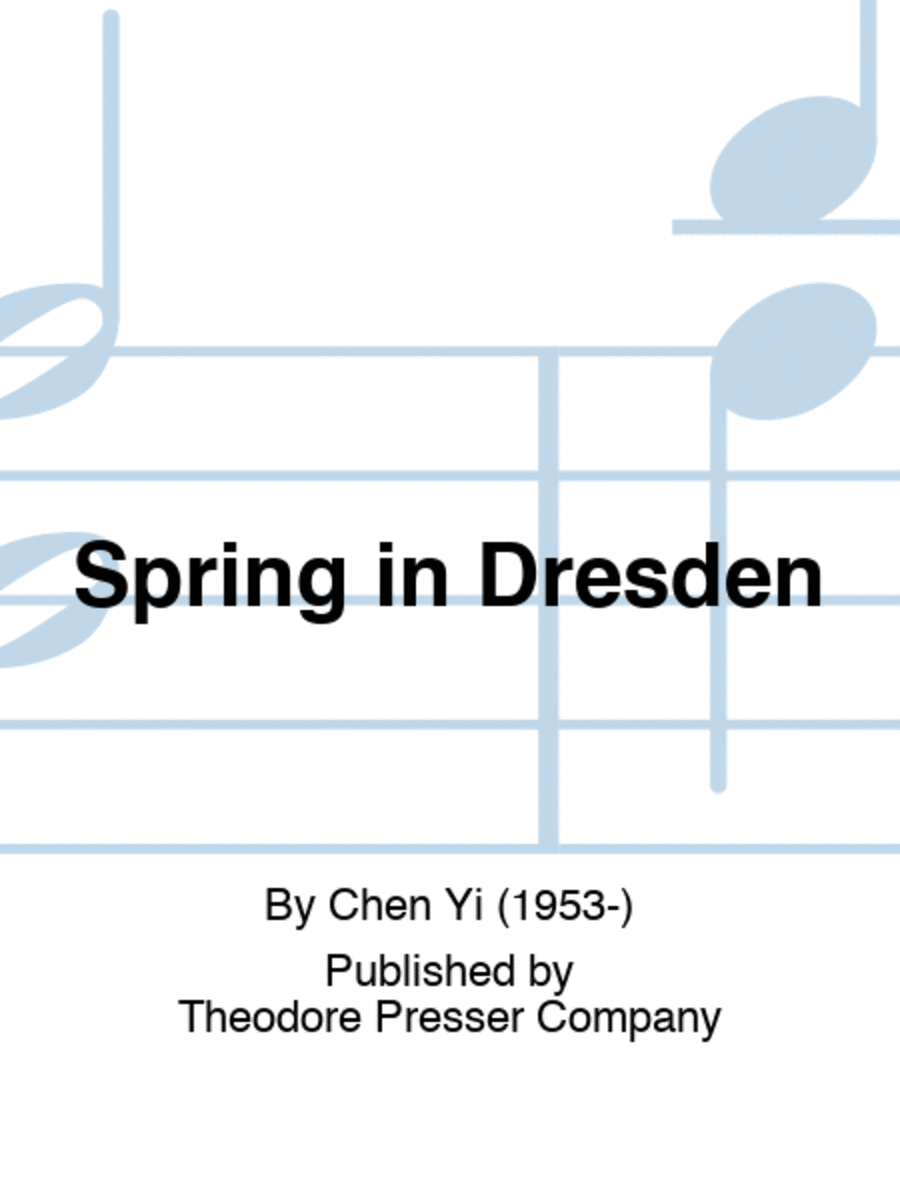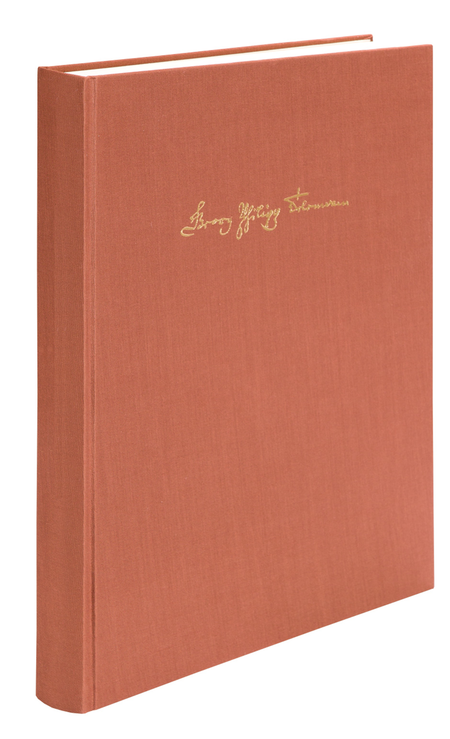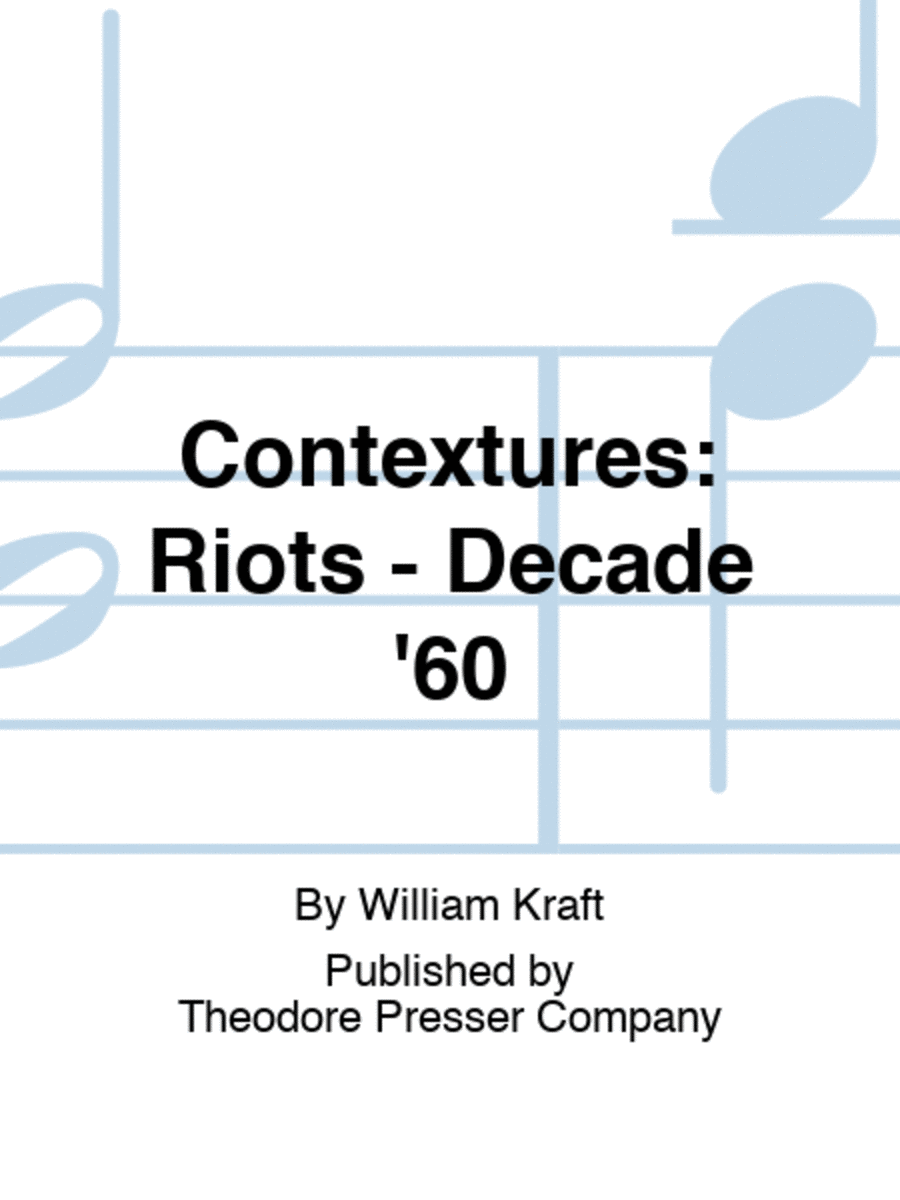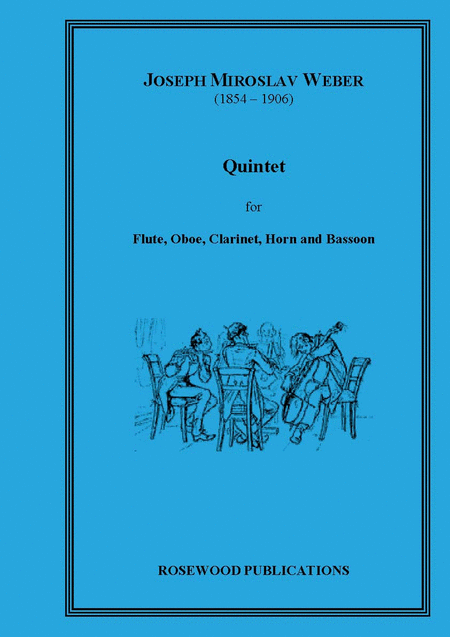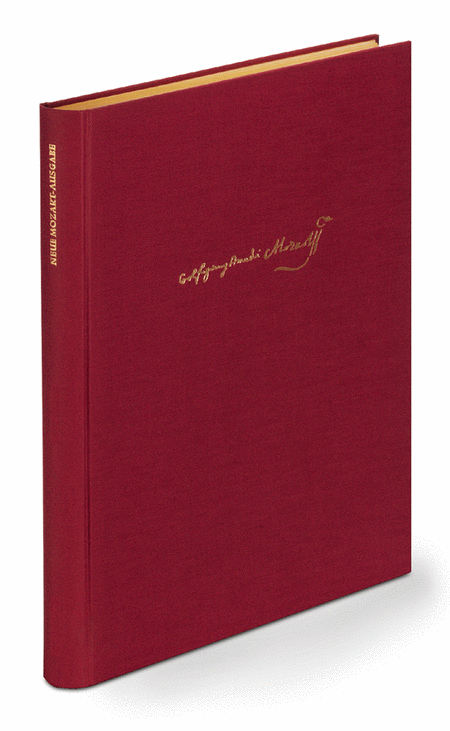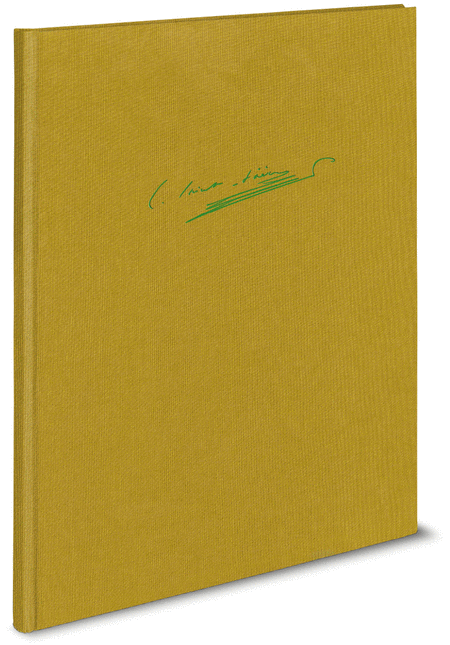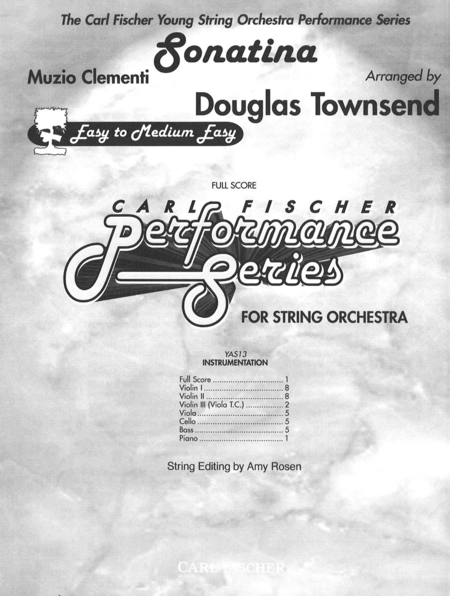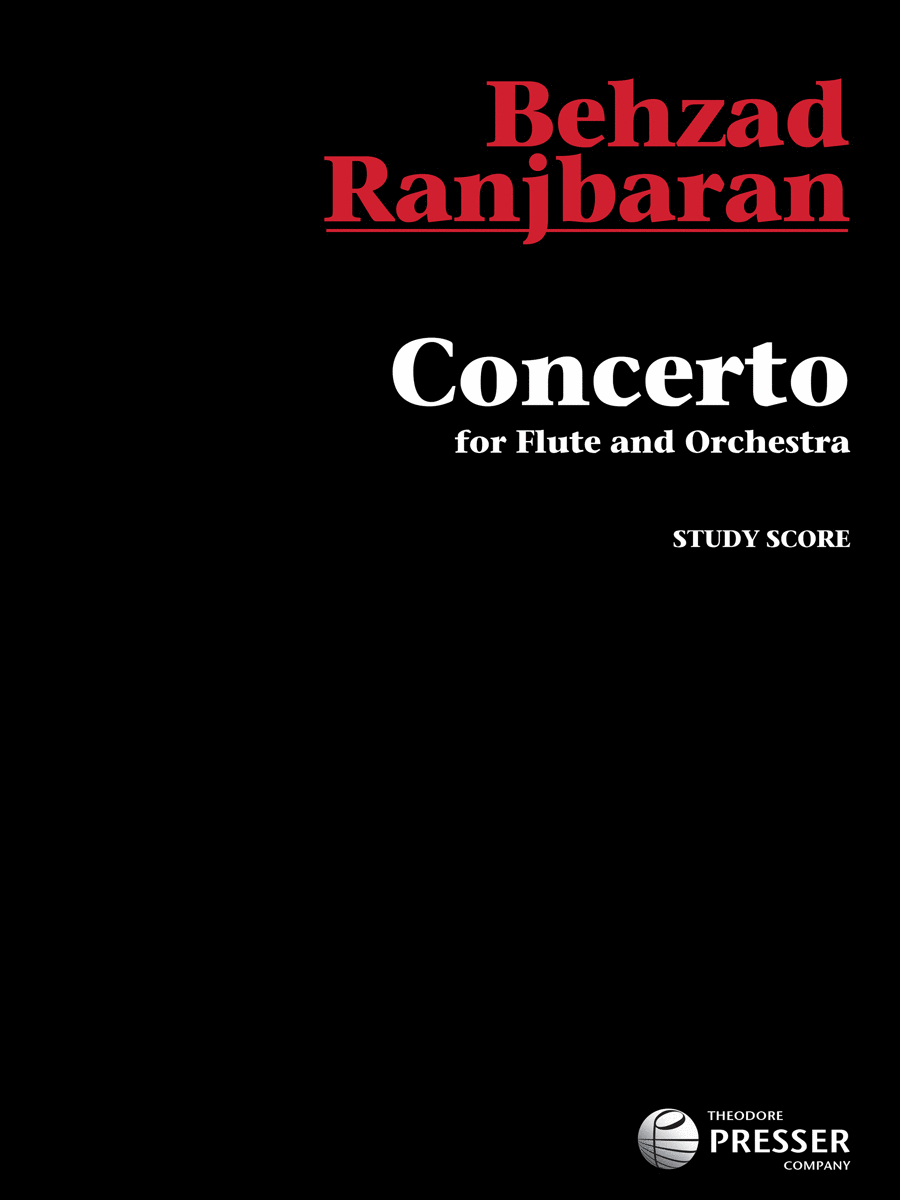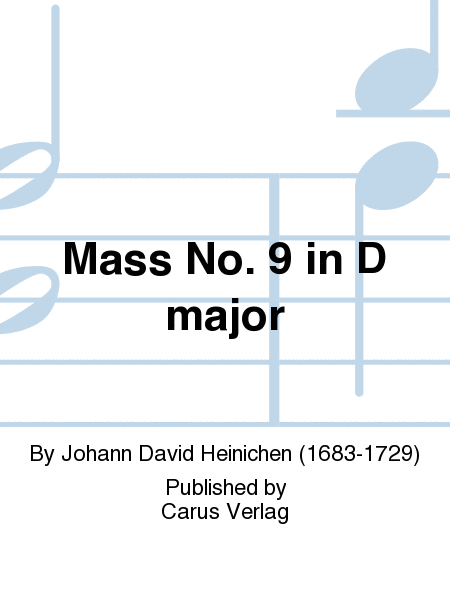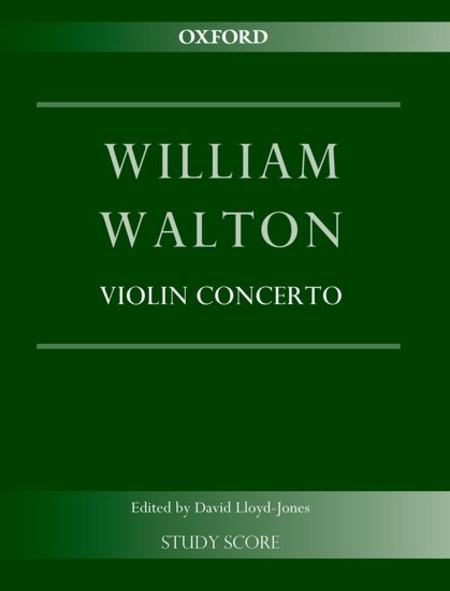|
| Concerto In B Flat For 2
Flûtes, Oboe And
Violin (TELEMANN GEORG
PHILIPP)
Parties Orchestrales [Partition]
Peters
Par TELEMANN GEORG PHILIPP. A La Vente - Partition D'Orchestre Disponible A La L...(+)
Par TELEMANN GEORG PHILIPP. A La Vente - Partition D'Orchestre Disponible A La Location Uniquement / oeuvre solo et Orchestre / Répertoire / Parties Orchestrales
Délais: 2-5 jours - En Stock Fournisseur | | |
| Concerto In B Flat For 2
Flûtes, Oboe And
Violin (TELEMANN GEORG
PHILIPP)
Parties Orchestrales [Partition]
Peters
Par TELEMANN GEORG PHILIPP. A La Vente - Partition D'Orchestre Disponible A La L...(+)
Par TELEMANN GEORG PHILIPP. A La Vente - Partition D'Orchestre Disponible A La Location Uniquement/ Répertoire / Parties Orchestrales
Délais: 2-5 jours - En Stock Fournisseur | | |
| Concerto In B Flat For 2
Flûtes, Oboe And
Violin (TELEMANN GEORG
PHILIPP)
Parties Orchestrales [Partition]
Peters
Par TELEMANN GEORG PHILIPP. A La Vente - Partition D'Orchestre Disponible A La L...(+)
Par TELEMANN GEORG PHILIPP. A La Vente - Partition D'Orchestre Disponible A La Location Uniquement/ Répertoire / Parties Orchestrales
Délais: 2-5 jours - En Stock Fournisseur | | |
| Concerto In E For
Flûte, Oboe
D'Amore And Viola
D'Amore (TELEMANN
GEORG PHILIPP)
Parties Orchestrales [Partition]
Peters
for Flute, Oboe d'amore and Viola d'amore. Par TELEMANN GEORG PHILIPP. Flûte Tr...(+)
for Flute, Oboe d'amore and Viola d'amore. Par TELEMANN GEORG PHILIPP. Flûte Traversière, Ob-d'a and Alto -d'a Soli - Strings - Basse Continue - Durée: 15 / oeuvre solo et Orchestre / Répertoire / Parties Orchestrales
Délais: 2-5 jours - En Stock Fournisseur | | |
| Concerto In E Twv53:E1
For Flûte, Oboe
D'Amore And Viola
D'Amore (TELEMANN
GEORG PHILIPP)
Parties Orchestrales [Partition]
Peters
for Flute, Oboe d'amore & Viola d'amore. Par TELEMANN GEORG PHILIPP. Flûte Trav...(+)
for Flute, Oboe d'amore & Viola d'amore. Par TELEMANN GEORG PHILIPP. Flûte Traversière, Ob-d'a and Alto -d'a Soli - Strings - Basse Continue - Durée: 16 / oeuvre solo et Orchestre / Répertoire / Parties Orchestrales
Délais: 2-5 jours - En Stock Fournisseur | | |
| Concerto In E Twv53:E1
For Flûte, Oboe
D'Amore And Viola
D'Amore (TELEMANN
GEORG PHILIPP)
Parties Orchestrales [Partition]
Peters
Par TELEMANN GEORG PHILIPP. Flûte Traversière, Ob-d'a and Alto -d'a Soli - Str...(+)
Par TELEMANN GEORG PHILIPP. Flûte Traversière, Ob-d'a and Alto -d'a Soli - Strings - Basse Continue - Durée: 16/ Répertoire / Parties Orchestrales
Délais: 2-5 jours - En Stock Fournisseur | | |
| Concerto In E For
Flûte, Oboe
D'Amore And Viola
D'Amore (TELEMANN
GEORG PHILIPP)
Parties Orchestrales [Partition]
Peters
Par TELEMANN GEORG PHILIPP. Flûte Traversière, Ob-d'a and Alto -d'a Soli - Str...(+)
Par TELEMANN GEORG PHILIPP. Flûte Traversière, Ob-d'a and Alto -d'a Soli - Strings - Basse Continue - Durée: 15/ Répertoire / Parties Orchestrales
Délais: 2-5 jours - En Stock Fournisseur | | |
| Flûte En Suite
Flûte traversière,
Orchestre
Schott
This ?Suite' is not one of my 'epic' instrumental concertos such as the concerto...(+)
This ?Suite' is not one of my 'epic' instrumental concertos such as the concertos for cello, violin or oboe, but a substantially smaller-structured series of dance forms arranged into a suite. Sunken worlds suddenly emerge here, only to reach the surface, hover in dangerously distorted fashion and then sink back to the bottom.Almost every individual movement allots the solo flute a specific tonal colouring and an instrumental group from the orchestra: in the opening Allemande, the flutes of the orchestra (including alto and bass flute and later also piccolo to include the entire flute family) - the string section in the Sarabande - in both chorales (extremely muted in the first and brutalist in the second), the brass etc. - and it is only in the concluding Badinerie that all orchestral groups are combined, although they are terraced in the Baroque style, one following another, seldom all playing simultaneously.This permits the flute to remain the provider of all impulses - it attaches itself to the wide variety of instrumental colours, becomes suffused with these colours and thereby shines in different lights - acerbic, pale and radiant. This first performance marks the conclusion of my two-year residence with the Cleveland Orchestra. The immense versatility of this fine body of sound (which is indeed treated as such with the sum of its parts) and the exciting dark timbre of its principal flautist Joshua Smith have to a great extent determined the form and tonal character of my Flûte en suite. Jörg Widmann / Flûte Et Orchestre
Délais: 2-5 jours - En Stock Fournisseur | | |
| Concerto In B Flat For 2
Flûtes, Oboe And
Violin (TELEMANN GEORG
PHILIPP)
Parties Orchestrales [Partition]
Peters
Par TELEMANN GEORG PHILIPP. A La Vente - Partition D'Orchestre Disponible A La L...(+)
Par TELEMANN GEORG PHILIPP. A La Vente - Partition D'Orchestre Disponible A La Location Uniquement/ Répertoire / Parties Orchestrales
Délais: 2-5 jours - En Stock Fournisseur | | |
| Concerto In B Flat For 2
Flûtes, Oboe And
Violin (TELEMANN GEORG
PHILIPP)
Parties Orchestrales [Partition]
Peters
Par TELEMANN GEORG PHILIPP. A La Vente - Partition D'Orchestre Disponible A La L...(+)
Par TELEMANN GEORG PHILIPP. A La Vente - Partition D'Orchestre Disponible A La Location Uniquement/ Répertoire / Parties Orchestrales
Délais: 2-5 jours - En Stock Fournisseur | | |
| Concerto In B Flat For 2
Flûtes, Oboe And
Violin (TELEMANN GEORG
PHILIPP)
Parties Orchestrales [Partition]
Peters
Par TELEMANN GEORG PHILIPP. A La Vente - Partition D'Orchestre Disponible A La L...(+)
Par TELEMANN GEORG PHILIPP. A La Vente - Partition D'Orchestre Disponible A La Location Uniquement/ Répertoire / Parties Orchestrales
Délais: 2-5 jours - En Stock Fournisseur | | |
| Concerto In E Twv53:E1
For Flûte, Oboe
D'Amore And Viola
D'Amore (TELEMANN
GEORG PHILIPP)
Parties Orchestrales [Partition]
Peters
for Flute, Oboe d'amore & Viola d'amore. Par TELEMANN GEORG PHILIPP. Viola part ...(+)
for Flute, Oboe d'amore & Viola d'amore. Par TELEMANN GEORG PHILIPP. Viola part / oeuvre solo et Orchestre / Répertoire / Parties Orchestrales
Délais: 2-5 jours - En Stock Fournisseur | | |
| Concerto In C For
Flûte, Oboe And
Orchestra (SALIERI
ANTONIO)
Flûte, Hautbois (duo)
Peters
Par SALIERI ANTONIO. Fl and Hautbois Soli - 0.0.0.1 - 2.2.0.0 - Strings - Durée...(+)
Par SALIERI ANTONIO. Fl and Hautbois Soli - 0.0.0.1 - 2.2.0.0 - Strings - Durée: 17 / oeuvre solo et Orchestre / Répertoire / Conducteur
Délais: 2-5 jours - En Stock Fournisseur | | |
| Concerto In E For
Flûte, Oboe
D'Amore And Viola
D'Amore (TELEMANN
GEORG PHILIPP)
Parties Orchestrales [Partition]
Peters
Par TELEMANN GEORG PHILIPP. Flûte Traversière, Ob-d'a and Alto -d'a Soli - Str...(+)
Par TELEMANN GEORG PHILIPP. Flûte Traversière, Ob-d'a and Alto -d'a Soli - Strings - Basse Continue - Durée: 15/ Répertoire / Parties Orchestrales
Délais: 2-5 jours - En Stock Fournisseur | | |
| Concerto In E For
Flûte, Oboe
D'Amore And Viola
D'Amore (TELEMANN
GEORG PHILIPP)
Parties Orchestrales [Partition]
Peters
Par TELEMANN GEORG PHILIPP. Flûte Traversière, Ob-d'a and Alto -d'a Soli - Str...(+)
Par TELEMANN GEORG PHILIPP. Flûte Traversière, Ob-d'a and Alto -d'a Soli - Strings - Basse Continue - Durée: 15/ Répertoire / Parties Orchestrales
Délais: 2-5 jours - En Stock Fournisseur | | |
| Concerto In E Twv53:E1
For Flûte, Oboe
D'Amore And Viola
D'Amore (TELEMANN
GEORG PHILIPP)
Parties Orchestrales [Partition]
Peters
Par TELEMANN GEORG PHILIPP. Flûte Traversière, Ob-d'a and Alto -d'a Soli - Str...(+)
Par TELEMANN GEORG PHILIPP. Flûte Traversière, Ob-d'a and Alto -d'a Soli - Strings - Basse Continue - Durée: 16/ Répertoire / Parties Orchestrales
Délais: 2-5 jours - En Stock Fournisseur | | |
| Concerto In C For
Flûte, Oboe And
Orchestra
Parties Orchestrales
Peters
9.10 EUR - vendu par LMI-partitions
Délais: 2-5 jours - En Stock Fournisseur | |
|
|
|
| ARKA - 3 Rituale (Full Score)
Voix basse, Piano [Conducteur]
Peters
Orchestra solo oboe, solo pipa, timpani 4 Pauken, 1 Spieler, percussion, (Crotal...(+)
Orchestra solo oboe, solo
pipa, timpani 4 Pauken, 1
Spieler, percussion,
(Crotali, Glockenspiel,
gr, Trommel,
vibraphonerafon - 1
Spieler), strings (7, 1)
SKU: PE.EP14445
Composed by Bernd Franke.
Full Scores. Edition
Peters. Score. 52 pages.
Duration 00:20:00.
Edition Peters
#98-EP14445. Published by
Edition Peters
(PE.EP14445). ISBN
9790014135041. 297 x 420
mm inches.
German. ARKA
stammt aus dem
Sanskrit und bedeutet so
viel wie Strahl, Blitz,
Sonne, Licht, aber auch
Lied, Feuer und Hymnus,
und entwickelt in meiner
Vorstellung sehr viele
unterschiedliche
Assoziationsfelder. In
ARKA stecken
auch die Worter arc
(beten) und ka (Wasser),
und es kann auch
ubersetzt werden mit:
,,Das Wasser stromt aus
dem heraus, der mehr
weiss. Mein neues
Werk fur Pipa, Oboe,
Pauke, Schlagzeug und
Orchester entstand im
Auftrag der
Kammerakademie Neuss und
auf Anregung des Oboisten
Christian Wetzel. Es
entstanden drei Rituale
mit zum Teil szenischen
Elementen fur die
Solisten und das
Orchester.
Inspirationsquelle in
der Vorbeschaftigung
waren zwei Quellen und
Bucher. Das Daodejing von
Laozi in der
hervorragenden
Neuubersetzung von Viktor
Kalinke, eine der
wichtigsten Quellen
chinesischen Denkens und
der Philosophie dieser
grossen Kulturtradition
und die chinesische
Tradition der
5-Elementelehre und der
Wandlungsphasen. Als
zweites Buch hat mich
,,Die Glut von Roberto
Calasso inspiriert, ein
Buch uber die indischen
Veden in Verbindung mit
den Ursprungen des
Buddhismus und den damit
verbunden Ritualen.
In den letzten 20
Jahren habe ich mich
intensiv mit
ostasiatischer Musik,
Kunst und Philosophie
beschaftigt und habe das
auch durch langere
Studienreisen und
kompositorische Projekte
vertiefen konnen. U.a.
wurde 2012 mein Chorwerk
PRAN in Kolkata in Indien
uraufgefuhrt
(Goethe-Institut),
ebenfalls 2012 ,,in
between VI fur Sho und
Sheng in Tokyo und 2013
,,Mirror and Circle fur
Pipa, Cello und
chinesisches Orchester in
Taipeh/Taiwan
(Auftragswerk der
taiwanesischen
Regierung). Mit der
chinesischen
Pipa-Virtuosin Ya Dong
arbeite ich seit 2000
zusammen und habe fur sie
mehrfach komponiert
(Urauffuhrungen u.a. in
Hannover/EXPO 2000,
Rottweil 2001, Taipeh
2013, Magdeburg 2016).
Auch mit Christian Wetzel
arbeite ich seit uber 20
Jahren zusammen und habe
ebenfalls haufig fur ihn
komponiert (UA u.a. in
Bonn 1999, Hannover/EXPO
2000, Rottweil 2001,
Darmstadt 2004 und
etliche weitere
Projekte). Jedes
dieser drei Rituale hat
eine Lange von ca. 6-7
Minuten und stellt
unterschiedliche
Qualitaten und
Besonderheiten der beiden
Soloinstrumente heraus,
immer in Verbindung mit
der Interaktion zwischen
Soli und Orchester. Die
Besetzung war fur mich
ausserst reizvoll, da
beide Instrumente in
dieser Kombination noch
nie so erklungen sind.
Die Pipa ist ein ungemein
modernes und
ungewohnliches
Instrument, reich an
Farben und vor allem an
perkussiven Effekten. Das
Tonmaterial wurde zum
grossten Teil aus den
Namen der beiden Solisten
gewonnen und ergibt
interessanter zwei
gespiegelte
Viertonmotive. In der
asiatischen Kultur
spielen der Spiegel und
der Kreis eine wichtige
Rolle, und so werden die
Tone, Rhythmen und Formen
eingewoben in diese drei
Rituale, welche am Ende
des dritten Satzes wieder
kreisformig an den Anfang
des ersten Rituals
anknupfen. Ein von den
Streichern und der Pauke
erzeugtes Gerausch,
verbunden mit dem
Rhythmus der grossen
Trommel, welcher einen
Herzschlag symbolisieren
soll. Die drei Untertitel
der Rituale Himmel, Erde
und (atmospharischer)
Raum spielen im vedischen
und chinesischen Denken
eine grosse Rolle und war
fur mich beim Komponieren
ebenfalls eine sehr
starke
Inspirationsquelle. In
vielen meiner
Kompositionen gibt es
Raumeffekte, Annaherungen
an das Publikum, das
Verschieben von
Perspektiven, die
Dekonstruktion und das
Hinterfragen der ublichen
Konzertsituation, so u.a
in meinem Beuys-Zyklus
oder in den Zyklen ,,CUT
und ,,in between.
In ARKA geht
es mir besonders um die
Interaktion zwischen
westlichem und ostlichem
Denken, um das
gegenseitige Durchdringen
dieser auf den ersten
Blick so
unterschiedlichen Denk-
und Lebensweisen, um eine
Verschmelzung scheinbarer
Gegensatze - um
Annaherung! Bernd
Franke. Leipzig,
11.10.2019 W01476|C|Y
0.0000 Sheet Music
_x000D_ 9780193556799 Y
23.50 X556799 357665
9780193556799 MISC C 1
432 8030 0.00 Oxford Solo
Songs: Christmas 14 songs
with piano PAPER 14
9780193556799 A-B CAROLS
CHRISTMAS MISC
MISCELLANEOUS OXFORD
PIANO SOLO SONGS SONGS:
VOICE WITH AB 00:00:0 Low
voice & piano Low voice
book + downloadable
backing tracks 311x232 72
NEW NONE 29/07/2021 P
355580 9780193556799
- Young: A babe is
born
- Rutter:
Angels' Carol
-
McDowall: Before the
paling of the stars
- Rutter:
Candlelight Carol
- Rutter: I sing
of a maiden
-
Chilcott: Mid-winter
- Todd: My Lord
has Come
-
Bullard: Scots Nativity
- Quartel: Snow
Angel
- Todd:
Softly
-
Chilcott: Sweet was the
song
- Chilcott:
The Shepherd's Carol
- Quartel: This
endris night
-
McGlade: What child is
this?
for
low voice and piano
This beautiful
collection of 14 songs
for low voice offers
Christmas settings by
some of Oxford's
best-loved composers.
Suitable for solo singers
and unison choirs alike,
each song is presented
with piano accompaniment,
and high-quality,
downloadable backing
tracks are included on a
companion website. With a
wonderful selection of
pieces, including
favourites such as Bob
Chilcott's 'The
Shepherd's Carol' and
John Rutter's
'Candlelight Carol', this
is the perfect collection
for use in carol services
and Christmas concerts or
for enjoying at home.
Also available in a
volume for high voice and
piano. - 14
songs for solo
voice
- Well-loved
composers, including John
Rutter and Bob
Chilcott
- Wide
selection of Christmas
texts
- Accessible
accompaniments
-
Includes backing tracks
downloadable from a
Companion
Website
-
Available in volumes for
high and low
voice
MISC|AU|Y
0.0000 Paperback _x000D_
EP73308R Y 0.00 73308R
P73308R 1 ORCHA 8000 0.00
Hover A (LARGE) BEAMISH
EP73308R GP:ORCHESTRAL
HOVER ONLY RENTAL SALLY
WORKS NONE ORCHA P 303000
EP73308R 0.0000 Sheet
Music _x000D_ EP14437A Y
22.95 14437A P14437A
FRANKE, BERND C
9790014137199 52A1 8000
0.00 AGNI A 9790014137199
AGNI BASS BERND CLARINET
EP14437A FRANKE
PHOTOPRINTS W01476
English / German 00:12:0
Instrumental Score 232 x
303 mm Bass clarinet 20
DETNT NEW PR43 23/04/2021
P 303006 AGNI is the
Hindu god of fire; the
elemental and
transformative force
inherent in
everything: Every
flame, every fire, every
light, every warmth is
AGNI. AGNI is
omnipresent, establishing
everything and ending
everything. AGNI is
often depicted with seven
tongues which represent
different aspects of his
being. These
include: creating,
sustaining, cleansing,
purifying, priestly,
martial, devastating,
destructive, and
consuming. Derived
from Franke's concerto of
the same name, this solo
work for bass clarinet
compositionally traces
the transformative
processes initiated by
the divine fire. The solo
takes seven pieces from
the concerto, presenting
vivid character pieces
exploring the creative
possibilities and wide
tonal range offered by
the bass
clarinet. This
version of AGNI
for bass clarinet solo
was premiered on 4
December 2020 in Leipzig
by Volker Hemken, the
principal bass
clarinetist of the
Gewandhausorchester
Leipzig. EP14437a
convinces with its
excellent and clear
notation, making the
piece a new standard for
bass clarinet.
W01476|C|Y 0.0000 Sheet
Music _x000D_ EP68686 Y
165.00 68686 P68686 LEWIS
C 9790300761299 97 8000
0.00 Ikons A
9790300761299
CONTEMPORARY ENSEMBLE
EP68686 GEORGE IKONS
LEWIS PHOTOPRINTS SMALL
W06652 English 00:14:0
Conductor Score & Parts
303 x 232 mm Fl (A-fl in
F).Cl.Bsn
(Cbsn).Tbn.Perc.Vln.Vlc.C
b 132 NEW PR43 USTNT
21/04/2021 P 303006
Ikons,
commissioned by the
Vancouver Cultural
Olympiad 2010, exists in
two forms. This 14-minute
acoustic version,
premiered by the Turning
Point Ensemble, calls for
an octet of live
musicians to execute
complex rhythms and
quarter-tone
harmonies. The
interactive, electronic
version, created with
visual artist Eric
Metcalfe and designed to
be presented separately,
incorporates samples from
this acoustic version
into a sculptural
environment of seven
pyramidal structures that
respond sonically to the
viewer. W06652|C|Y
0.0000 Sheet Music
_x000D_ EP73531 Y 31.95
73531 P73531 PANUFNIK,
ROXANNA C 9790577020976
61 8000 0.00 Sonnets
without Words A
9790577020976 EP73531
HORN PANUFNIK PHOTOPRINTS
PIANO ROXANNA SHAKESPEARE
SONNETS W03578 WILLIAM
WITHOUT WORDS English
Score & Instrumental
Parts 232 x 303 mm Horn
and piano 28 NEW PR43
UKTNT 21/04/2021 P 303006
Roxanna Panufnik's
Sonnets without
Words is a
contemporary piece for
Horn in F and piano.
Written for horn player
Ben Goldscheider,
Panufnik has reimagined
the lyrical vocal lines
from three of her
previous settings of
Shakespeare's sonnets
(Mine eye, Music to
hear and Sweet
Love Remember'd for
voice and piano) into a
purely instrumental
work. Score and
horn
part. - Contempo
rary work for Horn in F
and
piano
- Settings of
Sheakespeare's Sonnets 8,
24 & 29 in instrumental
form
W03578|C|Y
W06737|LY|N 0.0000 Sheet
Music _x000D_ EP73571 Y
15.95 73571 P73571
MCNEFF, STEPHEN C
9790577021317 20 8000
0.00 Trig for Solo Cello
A 9790577021317 (SOLO)
CELLO EP73571 MCNEFF
PHOTOPRINTS SOLO STEPHEN
TRIG W03150 English
00:07:0 Instrumental
Score 232 x 303 mm Solo
Violoncello 8 NEW PR43
UKTNT 21/04/2021 P 303006
Stephen McNeff's
Trig is a short
7-minute contemporary
work for solo cello,
written to celebrate the
bicentennial of the Royal
Academy of Music in 2022
and in memorium cellist
Mike Edwards
1948-2010. Trig
was premiered by
Henry Hargreaves on 19
March 2021, livestreamed
from the Royal Academy of
Music. - Contemp
orary piece for solo
cello
- Written for
the Royal Academy of
Music's
bicentennial
W03150|C|Y 0.0000 Sheet
Music _x000D_ EP14528 Y
34.95 14528 P14528
SAUNDERS, REBECCA C
9790014136796 3 8000 0.00
to an utterance - study A
9790014136796 (SOLO) AN
EP14528 PHOTOPRINTS PIANO
REBECCA SAUNDERS STUDY TO
UTTERANCE W04191 English
Instrumental Score 420 x
297 mm Piano Solo 16
DETNT NEW PR43 21/04/2021
P 303006 to an
utterance - study
was commissioned by
Klangforum Wien for the
premiere commercial audio
recording on a portrait
CD in 2020 and first
performed by Joonas
Ahonen at the Berlin
Philharmonie on 4th
September 2020 at the
Musikfest Berlin.
W04191|C|Y 0.0000 Sheet
Music _x000D_ EP71880 Y
75.00 71880 P71880
PANUFNIK, ROXANNA C
9790577008332 82 8000
0.00 Spirit Moves for
Brass Quintet A
9790577008332 BRASS
ENSEMBLE EP71880 MOVES
PANUFNIK PHOTOPRINTS
QUINTET ROXANNA SPIRIT
W03578 English 00:15:0
Score & Instrumental
Parts 232 x 303 mm
Trumpet 1 in B flat
(doubling Piccolo
Trumpet), Trumpet 2 in B
flat (doubling Flugel
Horn), Horn in F,
Trombone, Tuba 84 NEW
PR43 UKTNT 21/04/2021 P
303006 Roxanna
Panufnik's Spirit
Moves, for brass
quintet, was commissioned
by the Fine Arts Brass
Ensemble. This 15-minute
piece is scored for two
trumpets in Bb (one
doubling piccolo trumpet
and the other doubling
flugel horn), horn in F,
trombone and tuba. This
brass quintet is so
called because the outer
movements are highly
spirited and the
central one is
spiritual. This product consists of
score and parts.
W03578|C|Y 0.0000 Sheet
Music _x000D_ EP73585 Y
4.00 73585 P73585 369282
WILLIAMS, RODERICK C
9790577021591 1 151 8000
0.00 Eriskay Love Lilt A
9790577021591 (SECULAR)
CHORAL EP73585 ERISKAY
HALSTAN-USA LILT LOVE
RODERICK TRADITIONAL
W05152 WILLIAMS WORKS
English 00:03:0 190 x 272
mm SATB (divisi) and
piano 16 NEW PR30 UKTNT
20/05/2021 P 377788 A
gently flowing 3-minute
arrangement by Roderick
Williams for SATB (with
divisi) with piano
accompaniment that
captures the beauty of
this famous traditional
Hebridean love song. The
song text uses both old
dialect and English, each
verse ending with the
words, 'Sad am I without
thee'. - Commiss
ioned by The Sixteen
choir and recorded on
their 2021 album
'Goodnight
Beloved'
- Roderick
Williams is a
composer/arranger and
also a world-renowned
baritone
- The
arrangement is described
by Williams as 'having a
little nod to Ravel and
Grieg'
W05152|C|Y W04819|LY|N
0.0000 Sheet Music
_x000D_ 9780193556782 Y
23.50 X556782 357665
9780193556782 MISC C 1
432 8030 0.00 Oxford Solo
Songs: Christmas 14 songs
with piano PAPER 14
9780193556782 A-B CAROLS
CHRISTMAS MISC
MISCELLANEOUS OXFORD
PIANO SOLO SONGS SONGS:
VOICE WITH AB 00:00:0
High voice & piano High
voice book + downloadable
backing tracks 311x232 72
NEW NONE 29/07/2021 P
355580 9780193556782
- Young: A babe is
born
- Rutter:
Angels' Carol
-
McDowall: Before the
paling of the stars
- Rutter:
Candlelight Carol
- Rutter: I sing
of a maiden
-
Chilcott: Mid-winter
- Todd: My Lord
has Come
-
Bullard: Scots Nativity
- Quartel: Snow
Angel
- Todd:
Softly
-
Chilcott: Sweet was the
song
- Chilcott:
The Shepherd's Carol
- Quartel: This
endris night
-
McGlade: What child is
this?
for
high voice and piano
This beautiful
collection of 14 songs
for high voice offers
Christmas settings by
some of Oxford's
best-loved composers.
Suitable for solo singers
and unison choirs alike,
each song is presented
with piano accompaniment,
and high-quality,
downloadable backing
tracks are included on a
companion website. With a
wonderful selection of
pieces, including
favourites such as Bob
Chilcott's 'The
Shepherd's Carol' and
John Rutter's
'Candlelight Carol', this
is the perfect collection
for use in carol services
and Christmas concerts or
for enjoying at home.
Also available in a
volume for low voice and
piano. - 14
songs for solo high
voice
- Well-loved
composers, including John
Rutter and Bob
Chilcott
- Wide
selection of sacred and
secular Christmas
texts
- Accessible
accompaniments
-
Includes backing tracks
downloadable from a
Companion
Website
-
Available in volumes for
high and low solo
voice
MISC|AU|Y
0.0000 Paperback _x000D_
9780193559066 Y 4.25
X559066 357665
9780193559066 YOUNG C 1
444 8030 0.00 O splendour
of God's glory bright
PAPER 9780193559066
BRIGHT CHORAL GLORY GOD'S
MIXED OF OXFORD SACRED
SPLENDOUR TOBY VOICES
W06576 YOUNG C 00:03:30
SATB & organ Vocal score
254x178 SATB 20 NONE P
355580 9780193559066
for SATB and organ
This energetic
setting of words by St
Ambrose of Milan is a
real showstopper. With
pop-influences and a
sparkling organ part,
Young effortlessly fuses
modern and traditional
sound worlds, while
changes in key and metre
build up to an
invigorating finish.
Perfect for accomplished
choirs looking for
something different.
W06576|C|Y 0.0000
Paperback _x000D_
9780193554399 Y 2.60
X554399 357665
9780193554399 LASSUS,
ORLANDO DE C 1 445 8030
0.00 Oculus non vidit
PAPER 9780193554399
CHORAL DE KEANE LASSUS
MARK NON OCULUS ORLANDO
OXFORD SACRED UPPER VIDIT
VOICES W02750 B 00:01:30
SA unaccompanied Vocal
score 254x178 Upper
Voices - 3 parts or more
4 NONE 10/06/2021 P
355580 9780193554399
for SA unaccompanied
This simple, charming
two-part motet features
long melismatic phrases
that reflect the text (1
Corinthians 2: 9), such
as the rising melodic
line over three bars on
the word 'ascended'
(ascendit).
W02750|C|Y
W06960|E|N 0.0000
Paperback _x000D_
9780193954298 Y 3.35
X954298 357665
9780193954298 TALLIS,
THOMAS C 1 448 8030 0.00
Honor, virtus et potestas
PAPER 9780193954298
CANTICLES DUNKLEY ET
HONOR OXFORD POTESTAS
SALLY SERVICES TALLIS
THOMAS VIRTUS W04705 C
00:06:0 SAATB
unaccompanied Vocal score
MSER00020 SATB 12 NONE
28/05/2021 P 355580
9780193954298 for
SAATB unaccompanied.
This glorious musical
depiction of the honour,
strength, power and
authority of the Holy
Trinity by Thomas Tallis
is the third issue in the
CMS's series of great
English Responds from the
16th century, edited by
Sally Dunkley. Scored for
SAATB, it can be
performed either as a
motet or as a full
Responsory with plainsong
alternating with
polyphony. W04705|C|Y
W01184|E|N 0.0000
Paperback _x000D_ EP73527
Y 6.95 73527 P73527
BEAMISH, SALLY C
9790577020891 50 8000
0.00 The Parting Glass A
9790577020891 (SOLO)
BEAMISH CLARINET EP73527
GLASS PARTING PHOTOPRINTS
SALLY W00306 English
Score 232 x 303 mm
Clarinet 4 NEW PR43 UKTNT
12/12/2020 P 303006
Based on a traditional
Scottish/Irish 'farewell'
song, this short piece is
one of six works written
to express my love of
Scotland. After living
there for nearly half my
life, and raising a
family, I moved back to
England in 2018, and
remarried in 2019.
Of course, there were
many different emotions
attached to the move
south: especially the joy
and excitement of new
beginnings, and
reconnection with friends
from my youth.
But this piece
expresses the wrench I
experienced after a last
family meal in Glasgow,
and the realisation of
all I was about to leave
behind. I have
taken the melody of the
original song, and
expanded it, exploring
the detail of its
patterns, so that it
becomes a timeless
meditation. The
six pieces in the
'farewell' series are for
6 violas, string quintet,
string quartet, trio,
violin and clarinet duo,
and solo clarinet.
The Parting Glass
was composed in 2020
during the coronavirus
lockdown, which
intensified the feeling
of separation from my
Scottish family, as well
as from other musicians.
It was
commissioned by Vittorio
Ceccanti for the
ContempoArtEnsemble.
W00306|C|Y 0.0000 Sheet
Music _x000D_ EP73516 Y
6.95 73516 P73516
BEAMISH, SALLY C
9790577020747 20 8000
0.00 Maple A
9790577020747 (SOLO)
BEAMISH CELLO EP73516
MAPLE PHOTOPRINTS SALLY
W00306 English 00:06:0
Score 232 x 303 mm
Contemporary cello solo 8
NEW PR43 UKTNT 12/12/2020
P 303006 Seed; Spinning
Seed; Roots, shoots;
Leaves ; Flowers; Tree ;
Autumn ; Cello
Maple arose
from a commission to
write a work for solo
cello, to be performed
alongside readings from
artist John Newling's
collection of letters
entitled 'Dear Nature'; a
poetic manifestation of
our relationship with the
natural world. The
piece is in eight short
sections, to be
interspersed with
readings of groups of the
poems. It may also be
performed as a single
movement. It begins with
a seed - the seed of a
maple tree, as it hangs
on the mature tree, ready
to drop. The seeds are
like propellers,
sometimes travelling more
than a mile before
landing on the ground.
Maple follows
the growth of the tree to
maturity - which in
reality would take at
least a hundred years.
'Roots, shoots' grows
downwards and upwards
from a pedal note, and
the dance-like 'Flowers'
is followed by the
stately 'Tree', and then
the warm, cascading
'Autumn'. Maple is very
often the wood of choice
for the back of a
stringed instrument, and
the last section uses
open strings to explore
the full resonance of the
cello. The piece
starts with a 'seed' of
only five notes, which
grows into different
configurations. It is
intended to be played in
an improvisatory
style.
Maple was
co-commissioned by
Brighton Festival, Ars et
Terra Festival with SACEM
and Ditchling Arts and
Crafts Museum, to be
performed by Margarita
Balanas as part of the
Brighton Festival's 'Dear
Nature' project.
W00306|C|Y 0.0000 Sheet
Music _x000D_ EP73508 Y
39.95 73508 P73508
DILLON, JAMES C
9790577020648 3 8000 0.00
echo the angelus A
9790577020648 (SOLO)
ANGELUS DILLON ECHO
EP73508 JAMES PHOTOPRINTS
PIANO W01097 English
00:25:0 Score 232 x 303
mm Piano Solo 44 NEW PR43
UKTNT 12/01/2021 P 303006
First performed by
Noriko Kawai for
Huddersfield Contemporary
Music Festival, in a
broadcast from the Radio
Theatre, BBC Broadcasting
House, November
2020. Full of
beautifully crafted,
delicate
tintinnabulations -
Richard Morrison, The
Times This
product is Printed on
Demand and may take
several weeks to fulfill.
Please order from your
favorite retailer. $90.00 - Voir plus => AcheterDélais: 24 hours - In Stock | | | |
| Concerto - Piano And Orchestra - Solo Part
Schott
Piano and orchestra - difficult SKU: HL.49046544 For piano and orchest...(+)
Piano and orchestra -
difficult SKU:
HL.49046544 For
piano and orchestra.
Composed by Gyorgy
Ligeti. This edition:
Saddle stitching. Sheet
music. Edition Schott.
Softcover. Composed
1985-1988. Duration 24'.
Schott Music #ED23178.
Published by Schott Music
(HL.49046544). ISBN
9781705122655. UPC:
842819108726.
9.0x12.0x0.224
inches. I composed
the Piano Concerto in two
stages: the first three
movements during the
years 1985-86, the next
two in 1987, the final
autograph of the last
movement was ready by
January, 1988. The
concerto is dedicated to
the American conductor
Mario di Bonaventura. The
markings of the movements
are the following: 1.
Vivace molto ritmico e
preciso 2. Lento e
deserto 3. Vivace
cantabile 4. Allegro
risoluto 5. Presto
luminoso.The first
performance of the
three-movement Concerto
was on October 23rd, 1986
in Graz. Mario di
Bonaventura conducted
while his brother,
Anthony di Bonaventura,
was the soloist. Two days
later the performance was
repeated in the Vienna
Konzerthaus. After
hearing the work twice, I
came to the conclusion
that the third movement
is not an adequate
finale; my feeling of
form demanded
continuation, a
supplement. That led to
the composing of the next
two movements. The
premiere of the whole
cycle took place on
February 29th, 1988, in
the Vienna Konzerthaus
with the same conductor
and the same pianist. The
orchestra consisted of
the following: flute,
oboe, clarinet, bassoon,
horn, trumpet, tenor
trombone, percussion and
strings. The flautist
also plays the piccoIo,
the clarinetist, the alto
ocarina. The percussion
is made up of diverse
instruments, which one
musician-virtuoso can
play. It is more
practical, however, if
two or three musicians
share the instruments.
Besides traditional
instruments the
percussion part calls
also for two simple wind
instruments: the swanee
whistle and the
harmonica. The string
instrument parts (two
violins, viola, cello and
doubles bass) can be
performed soloistic since
they do not contain
divisi. For balance,
however, the ensemble
playing is recommended,
for example 6-8 first
violins, 6-8 second, 4-6
violas, 4-6 cellos, 3-4
double basses. In the
Piano Concerto I realized
new concepts of harmony
and rhythm. The first
movement is entirely
written in bimetry:
simultaneously 12/8 and
4/4 (8/8). This relates
to the known triplet on a
doule relation and in
itself is nothing new.
Because, however, I
articulate 12 triola and
8 duola pulses, an
entangled, up till now
unheard kind of polymetry
is created. The rhythm is
additionally complicated
because of asymmetric
groupings inside two
speed layers, which means
accents are
asymmetrically
distributed. These
groups, as in the talea
technique, have a fixed,
continuously repeating
rhythmic structures of
varying lengths in speed
layers of 12/8 and 4/4.
This means that the
repeating pattern in the
12/8 level and the
pattern in the 4/4 level
do not coincide and
continuously give a
kaleidoscope of renewing
combinations. In our
perception we quickly
resign from following
particular rhythmical
successions and that what
is going on in time
appears for us as
something static,
resting. This music, if
it is played properly, in
the right tempo and with
the right accents inside
particular layers, after
a certain time 'rises, as
it were, as a plane after
taking off: the rhythmic
action, too complex to be
able to follow in detail,
begins flying. This
diffusion of individual
structures into a
different global
structure is one of my
basic compositional
concepts: from the end of
the fifties, from the
orchestral works
Apparitions and
Atmospheres I
continuously have been
looking for new ways of
resolving this basic
question. The harmony of
the first movement is
based on mixtures, hence
on the parallel leading
of voices. This technique
is used here in a rather
simple form; later in the
fourth movement it will
be considerably
developed. The second
movement (the only slow
one amongst five
movements) also has a
talea type of structure,
it is however much
simpler rhythmically,
because it contains only
one speed layer. The
melody is consisted in
the development of a
rigorous interval mode in
which two minor seconds
and one major second
alternate therefore nine
notes inside an octave.
This mode is transposed
into different degrees
and it also determines
the harmony of the
movement; however, in
closing episode in the
piano part there is a
combination of diatonics
(white keys) and
pentatonics (black keys)
led in brilliant,
sparkling quasimixtures,
while the orchestra
continues to play in the
nine tone mode. In this
movement I used isolated
sounds and extreme
registers (piccolo in a
very low register,
bassoon in a very high
register, canons played
by the swanee whistle,
the alto ocarina and
brass with a harmon-mute'
damper, cutting sound
combinations of the
piccolo, clarinet and
oboe in an extremely high
register, also
alternating of a
whistle-siren and
xylophone). The third
movement also has one
speed layer and because
of this it appears as
simpler than the first,
but actually the rhythm
is very complicated in a
different way here. Above
the uninterrupted, fast
and regular basic pulse,
thanks to the asymmetric
distribution of accents,
different types of
hemiolas and inherent
melodical patterns appear
(the term was coined by
Gerhard Kubik in relation
to central African
music). If this movement
is played with the
adequate speed and with
very clear accentuation,
illusory
rhythmic-melodical
figures appear. These
figures are not played
directly; they do not
appear in the score, but
exist only in our
perception as a result of
co-operation of different
voices. Already earlier I
had experimented with
illusory rhythmics,
namely in Poeme
symphonique for 100
metronomes (1962), in
Continuum for harpsichord
(1968), in Monument for
two pianos (1976), and
especially in the first
and sixth piano etude
Desordre and Automne a
Varsovie (1985). The
third movement of the
Piano Concerto is up to
now the clearest example
of illusory rhythmics and
illusory melody. In
intervallic and chordal
structure this movement
is based on alternation,
and also inter-relation
of various modal and
quasi-equidistant harmony
spaces. The tempered
twelve-part division of
the octave allows for
diatonical and other
modal interval
successions, which are
not equidistant, but are
based on the alternation
of major and minor
seconds in different
groups. The tempered
system also allows for
the use of the
anhemitonic pentatonic
scale (the black keys of
the piano). From
equidistant scales,
therefore interval
formations which are
based on the division of
an octave in equal
distances, the
twelve-tone tempered
system allows only
chromatics (only minor
seconds) and the six-tone
scale (the whole-tone:
only major seconds).
Moreover, the division of
the octave into four
parts only minor thirds)
and three parts (three
major thirds) is
possible. In several
music cultures different
equidistant divisions of
an octave are accepted,
for example, in the
Javanese slendro into
five parts, in Melanesia
into seven parts, popular
also in southeastern
Asia, and apart from
this, in southern Africa.
This does not mean an
exact equidistance: there
is a certain tolerance
for the inaccurateness of
the interval tuning.
These exotic for us,
Europeans, harmony and
melody have attracted me
for several years.
However I did not want to
re-tune the piano
(microtone deviations
appear in the concerto
only in a few places in
the horn and trombone
parts led in natural
tones). After the period
of experimenting, I got
to pseudo- or
quasiequidistant
intervals, which is
neither whole-tone nor
chromatic: in the
twelve-tone system, two
whole-tone scales are
possible, shifted a minor
second apart from each
other. Therefore, I
connect these two scales
(or sound resources), and
for example, places occur
where the melodies and
figurations in the piano
part are created from
both whole tone scales;
in one band one six-tone
sound resource is
utilized, and in the
other hand, the
complementary. In this
way whole-tonality and
chromaticism mutually
reduce themselves: a type
of deformed
equidistancism is formed,
strangely brilliant and
at the same time
slanting; illusory
harmony, indeed being
created inside the
tempered twelve-tone
system, but in sound
quality not belonging to
it anymore. The
appearance of such
slantedequidistant
harmony fields
alternating with modal
fields and based on
chords built on fifths
(mainly in the piano
part), complemented with
mixtures built on fifths
in the orchestra, gives
this movement an
individual, soft-metallic
colour (a metallic sound
resulting from
harmonics). The fourth
movement was meant to be
the central movement of
the Concerto. Its
melodc-rhythmic elements
(embryos or fragments of
motives) in themselves
are simple. The movement
also begins simply, with
a succession of
overlapping of these
elements in the mixture
type structures. Also
here a kaleidoscope is
created, due to a limited
number of these elements
- of these pebbles in the
kaleidoscope - which
continuously return in
augmentations and
diminutions. Step by
step, however, so that in
the beginning we cannot
hear it, a compiled
rhythmic organization of
the talea type gradually
comes into daylight,
based on the simultaneity
of two mutually shifted
to each other speed
layers (also triplet and
duoles, however, with
different asymmetric
structures than in the
first movement). While
longer rests are
gradually filled in with
motive fragments, we
slowly come to the
conclusion that we have
found ourselves inside a
rhythmic-melodical whirl:
without change in tempo,
only through increasing
the density of the
musical events, a
rotation is created in
the stream of successive
and compiled, augmented
and diminished motive
fragments, and increasing
the density suggests
acceleration. Thanks to
the periodical structure
of the composition,
always new but however of
the same (all the motivic
cells are similar to
earlier ones but none of
them are exactly
repeated; the general
structure is therefore
self-similar), an
impression is created of
a gigantic, indissoluble
network. Also, rhythmic
structures at first
hidden gradually begin to
emerge, two independent
speed layers with their
various internal
accentuations. This
great, self-similar whirl
in a very indirect way
relates to musical
associations, which came
to my mind while watching
the graphic projection of
the mathematical sets of
Julia and of Mandelbrot
made with the help of a
computer. I saw these
wonderful pictures of
fractal creations, made
by scientists from Brema,
Peitgen and Richter, for
the first time in 1984.
From that time they have
played a great role in my
musical concepts. This
does not mean, however,
that composing the fourth
movement I used
mathematical methods or
iterative calculus;
indeed, I did use
constructions which,
however, are not based on
mathematical thinking,
but are rather craftman's
constructions (in this
respect, my attitude
towards mathematics is
similar to that of the
graphic artist Maurits
Escher). I am concerned
rather with intuitional,
poetic, synesthetic
correspondence, not on
the scientific, but on
the poetic level of
thinking. The fifth, very
short Presto movement is
harmonically very simple,
but all the more
complicated in its
rhythmic structure: it is
based on the further
development of ''inherent
patterns of the third
movement. The
quasi-equidistance system
dominates harmonically
and melodically in this
movement, as in the
third, alternating with
harmonic fields, which
are based on the division
of the chromatic whole
into diatonics and
anhemitonic pentatonics.
Polyrhythms and harmonic
mixtures reach their
greatest density, and at
the same time this
movement is strikingly
light, enlightened with
very bright colours: at
first it seems chaotic,
but after listening to it
for a few times it is
easy to grasp its
content: many autonomous
but self-similar figures
which crossing
themselves. I present my
artistic credo in the
Piano Concerto: I
demonstrate my
independence from
criteria of the
traditional avantgarde,
as well as the
fashionable
postmodernism. Musical
illusions which I
consider to be also so
important are not a goal
in itself for me, but a
foundation for my
aesthetical attitude. I
prefer musical forms
which have a more
object-like than
processual character.
Music as frozen time, as
an object in imaginary
space evoked by music in
our imagination, as a
creation which really
develops in time, but in
imagination it exists
simultaneously in all its
moments. The spell of
time, the enduring its
passing by, closing it in
a moment of the present
is my main intention as a
composer. (Gyorgy
Ligeti). $34.00 - Voir plus => AcheterDélais: 24 hours - In Stock | | | |
| Peter Maxwell Davies: Strathclyde Concerto No. 6 (Flute Part)
Flûte traversière et Piano
Chester
Flute and Piano (Score) SKU: HL.14008426 Strathclyde Concerto No. 6 (F...(+)
Flute and Piano (Score)
SKU: HL.14008426
Strathclyde Concerto
No. 6 (Flute Part).
Composed by Sir Peter
Maxwell Davies. Music
Sales America. Classical.
Book [Softcover].
Composed 1999. 60 pages.
Chester Music #CH61024.
Published by Chester
Music (HL.14008426).
ISBN
9780711942042. The
solo flute here is kept
in high profile by the
absence from the
orchestra not only of
other flutes, but also of
violins and oboes; in
addition, the trumpets
are used sparingly (they
do not, for instance,
play in the slow
movement), so that for
much of the time the
flute is playing against
a mellow ensemble of
clarinets, horns,
bassoons and low strings.
If this is, nevertheless,
one of Davies's most
open-spirited pieces,
that comes partly from
the ready flights of the
soloist, partly from its
glockenspiel
accompaniments in the
outer movements (replaced
by ticking claves in the
Adagio), partly from the
dancing character of so
much of the music, and
partly from the harmonic
clarity, in a light
region not far from C
minor. Flute part with
piano reduction of the
orchestral score. $27.95 - Voir plus => AcheterDélais: 2 to 3 weeks | | | |
| Spring in Dresden [Conducteur]
Theodore Presser Co.
Orchestra Bass Drum, Bassoon 1, Bassoon 2, Clarinet 1, Clarinet 2, Contrabass, F...(+)
Orchestra Bass Drum,
Bassoon 1, Bassoon 2,
Clarinet 1, Clarinet 2,
Contrabass, Flute 1,
Flute 2, Harp, Horn 1,
Horn 2, Horn 3, Horn 4,
Marimba, Oboe 1, Oboe 2,
Percussion 1, Percussion
2, Percussion 3, Snare
Drum, Suspended Cymbal,
Tam-tam, Trombone 1 and
more. SKU:
PR.11641963S Composed
by Chen Yi. Full score.
58 pages. Duration 20
minutes. Theodore Presser
Company #116-41963S.
Published by Theodore
Presser Company
(PR.11641963S). UPC:
680160684472. The
violin concerto is
commissioned by Friends
of Dresden Music
Foundation for American
soloist Mira Wang and the
New York Philharmonic and
Staatskapelle Dresden as
an American commemoration
of the reconstruction of
the Dresden Frauenkirche,
60 years after its
destruction in World War
II by American and
British Forces. The world
premiere is given at the
Semperoper in Dresden,
Germany, on October 9, 10
& 11, 2005, conducted
by Ivan Fischer. Full of
excitement and inner
power, the musical image
is vivid, energetic,
sometimes lyrical and
sometimes dramatic. The
major angular thematic
material (a three note
motive) consists of big
leaps in interval (a
perfect fourth downward
and then a minor seventh
upward, first introduced
by the violin solo in
measures 27-29). Except
for the cadenzas which
stand at the middle
(Rehearsal E, measure
127) and the two ends of
the piece as a frame, the
virtuosic violin solo
line is always
accompanied by the ever
moving and growing
textures in the
background. The rests
between long and short
phrases symbolize the
space in Chinese
paintings. The Beijing
Opera reciting tune, and
the fingerings to produce
sliding tones in the
performance of the
Chinese fiddle erhu are
also borrowed in the
writing and the
performing of the western
instruments. The musical
imagination of the violin
concerto came from an
ancient Chinese poem with
the same title, written
by Du Fu (712-770) in
Tang Dynasty. Happy Rain
on a Spring Night by Du
Fu (712-770 in Tang
Dynasty) Happy rain comes
in time, When spring is
in its prime. With night
breeze it will fall, And
quietly moisten all.
Clouds darken wild roads,
Light brightens a little
boat. Saturated at dawn,
With flowers blooming the
town. (English
translation by Chen Yi
from the original poem in
Chinese) The following is
the poem in its original
Chinese form, and the
detailed introduction on
the structural plan of
the violin concerto
Spring in Dresden. It's
like the welcome rain on
a quiet spring night that
nurtures the budding
seeds, our new society is
pushing us forward to the
new future. The music
reflects the scenes and
the expression according
to the meaning of the
poem when it's being
unfolded line by line.
Although the tempo is set
63 quarter notes per
minute throughout (played
vividly, never slow
down), the tension is
being built up from the
quiet background in the
beginning, to the
sustained climax towards
the end. The musical
image in Rehearsal A and
B (measures 39-80)
represents the first four
lines of the poem. The
wind instruments response
to the rustling of fast
moving notes on muted
string triplets,
decorated by occasional
strokes produced by
metallic string sound and
high woodwind gestures.
The music in Rehearsal C
and D (measures 81-126)
represents the next two
lines of the poem. It's
so dark, a little light
in the boat is shimmering
on the lake... The
breathy sound and key
slaps on the flutes
create a mysterious
atmosphere, in a dialogue
with other instruments.
The cello glissandi
recite the poem in the
tone of Mandarin, echoed
by the string harmonics.
The music in Rehearsal F,
G and H (m 129-202) is a
toccata, starting in the
orchestra (led by the
marimba), which builds up
a big shape, to reach the
climax in m. 157
(Rehearsal G, the
location of the Golden
Section, according to the
length of the music
without cadenzas), and
keeps the vivid scene
towards the coda (from
Rehearsal I, m. 203),
which stands on the
energetic peak until the
clear cutoff on measure
239, followed by the
short, yet powerful solo
conclusion with the
lingering echo produced
by the high string
harmonics. On the top,
there is a recall of the
three note motive in the
sound of wonderland,
touched by the motor-on
vibraphone meaningfully.
The music is written for
2 flutes, 2 oboes, 2
clarinets (in Bb), 2
bassoons, 4 French horns
(in F), 2 trumpets (in
Bb), 3 trombones, tuba,
harp, 3 percussion
players (Perc. 1:
xylophone; Perc. 2:
suspended cymbal,
Japanese high woodblock,
snare drum, bass drum and
vibraphone; Perc. 3:
marimba and tam-tam),
solo violin, and strings.
Duration is about 20
minutes.
The violin
concerto is commissioned
by Friends of Dresden
Music Foundation for
American soloist Mira
Wang and the New York
Philharmonic and
Staatskapelle Dresden as
an American commemoration
of the reconstruction of
the Dresden Frauenkirche,
60 years after its
destruction in World War
II by American and
British Forces. The world
premiere is given at the
Semperoper in Dresden,
Germany, on October 9, 10
& 11, 2005, conducted by
Ivan Fischer.Full of
excitement and inner
power, the musical image
is vivid, energetic,
sometimeslyrical and
sometimes dramatic. The
major angular thematic
material (a three
notemotive) consists of
big leaps in interval (a
perfect fourth downward
and then a minorseventh
upward, first introduced
by the violin solo in
measures 27-29). Except
for thecadenzas which
stand at the middle
(Rehearsal E, measure
127) and the two ends of
the piece as a frame, the
virtuosic violin solo
line is always
accompanied by the ever
moving and growing
textures in the
background. The rests
between long and short
phrases symbolize the
space in Chinese
paintings. The Beijing
Opera reciting tune, and
the fingerings to produce
sliding tones in the
performance of the
Chinese fiddle erhu are
also borrowed in the
writing and the
performing of the western
instruments.The musical
imagination of the violin
concerto came from an
ancient Chinese poem with
the same title, written
by Du Fu (712-770) in
Tang Dynasty.Happy Rain
on a Spring Nightby Du Fu
(712-770 in Tang
Dynasty)Happy rain comes
in time,When spring is in
its prime.With night
breeze it will fall,And
quietly moisten
all.Clouds darken wild
roads,Light brightens a
little boat.Saturated at
dawn,With flowers
blooming the
town.(English translation
by Chen Yi from the
original poem in
Chinese)The following is
the poem in its original
Chinese form, and the
detailed introduction
onthe structural plan of
the violin concerto
Spring in
Dresden.It’s like
the welcome rain on a
quiet spring night that
nurtures the budding
seeds, our newsociety is
pushing us forward to the
new future. The music
reflects the scenes and
theexpression according
to the meaning of the
poem when it’s
being unfolded line by
line.Although the tempo
is set 63 quarter notes
per minute throughout
(played vividly,
neverslow down), the
tension is being built up
from the quiet background
in the beginning, tothe
sustained climax towards
the end. The musical
image in Rehearsal A and
B (measures39-80)
represents the first four
lines of the poem. The
wind instruments response
to therustling of fast
moving notes on muted
string triplets,
decorated by occasional
strokesproduced by
metallic string sound and
high woodwind gestures.
The music in RehearsalC
and D (measures 81-126)
represents the next two
lines of the poem. It's
so dark, a littlelight in
the boat is shimmering on
the lake... The breathy
sound and key slaps on
theflutes create a
mysterious atmosphere, in
a dialogue with other
instruments. The
celloglissandi recite the
poem in the tone of
Mandarin, echoed by the
string harmonics.
Themusic in Rehearsal F,
G and H (m 129-202) is a
toccata, starting in the
orchestra (led bythe
marimba), which builds up
a big shape, to reach the
climax in m. 157
(Rehearsal G,the location
of the Golden Section,
according to the length
of the music
withoutcadenzas), and
keeps the vivid scene
towards the coda (from
Rehearsal I, m. 203),
whichstands on the
energetic peak until the
clear cutoff on measure
239, followed by the
short,yet powerful solo
conclusion with the
lingering echo produced
by the high
stringharmonics. On the
top, there is a recall of
the three note motive in
the sound ofwonderland,
touched by the motor-on
vibraphone
meaningfully.The music is
written for 2 flutes, 2
oboes, 2 clarinets (in
Bb), 2 bassoons, 4 French
horns (in F), 2 trumpets
(in Bb), 3 trombones,
tuba, harp, 3 percussion
players (Perc.
1:xylophone; Perc. 2:
suspended cymbal,
Japanese high woodblock,
snare drum, bass drum and
vibraphone; Perc. 3:
marimba and tam-tam),
solo violin, and
strings.Duration is about
20 minutes. $35.99 - Voir plus => AcheterDélais: 2 to 3 weeks | | | |
| Spring in Dresden
Theodore Presser Co.
Orchestra Bass Drum, Bassoon 1, Bassoon 2, Clarinet 1, Clarinet 2, Contrabass, F...(+)
Orchestra Bass Drum,
Bassoon 1, Bassoon 2,
Clarinet 1, Clarinet 2,
Contrabass, Flute 1,
Flute 2, Harp, Horn 1,
Horn 2, Horn 3, Horn 4,
Marimba, Oboe 1, Oboe 2,
Percussion 1, Percussion
2, Percussion 3, Snare
Drum, Suspended Cymbal,
Tam-tam, Trombone 1 and
more. SKU:
PR.11641963SP
Composed by Chen Yi.
Part. 11 pages. Duration
20 minutes. Theodore
Presser Company
#116-41963SP. Published
by Theodore Presser
Company (PR.11641963SP).
UPC:
680160684496. The
violin concerto is
commissioned by Friends
of Dresden Music
Foundation for American
soloist Mira Wang and the
New York Philharmonic and
Staatskapelle Dresden as
an American commemoration
of the reconstruction of
the Dresden Frauenkirche,
60 years after its
destruction in World War
II by American and
British Forces. The world
premiere is given at the
Semperoper in Dresden,
Germany, on October 9, 10
& 11, 2005, conducted
by Ivan Fischer. Full of
excitement and inner
power, the musical image
is vivid, energetic,
sometimes lyrical and
sometimes dramatic. The
major angular thematic
material (a three note
motive) consists of big
leaps in interval (a
perfect fourth downward
and then a minor seventh
upward, first introduced
by the violin solo in
measures 27-29). Except
for the cadenzas which
stand at the middle
(Rehearsal E, measure
127) and the two ends of
the piece as a frame, the
virtuosic violin solo
line is always
accompanied by the ever
moving and growing
textures in the
background. The rests
between long and short
phrases symbolize the
space in Chinese
paintings. The Beijing
Opera reciting tune, and
the fingerings to produce
sliding tones in the
performance of the
Chinese fiddle erhu are
also borrowed in the
writing and the
performing of the western
instruments. The musical
imagination of the violin
concerto came from an
ancient Chinese poem with
the same title, written
by Du Fu (712-770) in
Tang Dynasty. Happy Rain
on a Spring Night by Du
Fu (712-770 in Tang
Dynasty) Happy rain comes
in time, When spring is
in its prime. With night
breeze it will fall, And
quietly moisten all.
Clouds darken wild roads,
Light brightens a little
boat. Saturated at dawn,
With flowers blooming the
town. (English
translation by Chen Yi
from the original poem in
Chinese) The following is
the poem in its original
Chinese form, and the
detailed introduction on
the structural plan of
the violin concerto
Spring in Dresden. It's
like the welcome rain on
a quiet spring night that
nurtures the budding
seeds, our new society is
pushing us forward to the
new future. The music
reflects the scenes and
the expression according
to the meaning of the
poem when it's being
unfolded line by line.
Although the tempo is set
63 quarter notes per
minute throughout (played
vividly, never slow
down), the tension is
being built up from the
quiet background in the
beginning, to the
sustained climax towards
the end. The musical
image in Rehearsal A and
B (measures 39-80)
represents the first four
lines of the poem. The
wind instruments response
to the rustling of fast
moving notes on muted
string triplets,
decorated by occasional
strokes produced by
metallic string sound and
high woodwind gestures.
The music in Rehearsal C
and D (measures 81-126)
represents the next two
lines of the poem. It's
so dark, a little light
in the boat is shimmering
on the lake... The
breathy sound and key
slaps on the flutes
create a mysterious
atmosphere, in a dialogue
with other instruments.
The cello glissandi
recite the poem in the
tone of Mandarin, echoed
by the string harmonics.
The music in Rehearsal F,
G and H (m 129-202) is a
toccata, starting in the
orchestra (led by the
marimba), which builds up
a big shape, to reach the
climax in m. 157
(Rehearsal G, the
location of the Golden
Section, according to the
length of the music
without cadenzas), and
keeps the vivid scene
towards the coda (from
Rehearsal I, m. 203),
which stands on the
energetic peak until the
clear cutoff on measure
239, followed by the
short, yet powerful solo
conclusion with the
lingering echo produced
by the high string
harmonics. On the top,
there is a recall of the
three note motive in the
sound of wonderland,
touched by the motor-on
vibraphone meaningfully.
The music is written for
2 flutes, 2 oboes, 2
clarinets (in Bb), 2
bassoons, 4 French horns
(in F), 2 trumpets (in
Bb), 3 trombones, tuba,
harp, 3 percussion
players (Perc. 1:
xylophone; Perc. 2:
suspended cymbal,
Japanese high woodblock,
snare drum, bass drum and
vibraphone; Perc. 3:
marimba and tam-tam),
solo violin, and strings.
Duration is about 20
minutes.
The violin
concerto is commissioned
by Friends of Dresden
Music Foundation for
American soloist Mira
Wang and the New York
Philharmonic and
Staatskapelle Dresden as
an American commemoration
of the reconstruction of
the Dresden Frauenkirche,
60 years after its
destruction in World War
II by American and
British Forces. The world
premiere is given at the
Semperoper in Dresden,
Germany, on October 9, 10
& 11, 2005, conducted by
Ivan Fischer.Full of
excitement and inner
power, the musical image
is vivid, energetic,
sometimeslyrical and
sometimes dramatic. The
major angular thematic
material (a three
notemotive) consists of
big leaps in interval (a
perfect fourth downward
and then a minorseventh
upward, first introduced
by the violin solo in
measures 27-29). Except
for thecadenzas which
stand at the middle
(Rehearsal E, measure
127) and the two ends of
the piece as a frame, the
virtuosic violin solo
line is always
accompanied by the ever
moving and growing
textures in the
background. The rests
between long and short
phrases symbolize the
space in Chinese
paintings. The Beijing
Opera reciting tune, and
the fingerings to produce
sliding tones in the
performance of the
Chinese fiddle erhu are
also borrowed in the
writing and the
performing of the western
instruments.The musical
imagination of the violin
concerto came from an
ancient Chinese poem with
the same title, written
by Du Fu (712-770) in
Tang Dynasty.Happy Rain
on a Spring Nightby Du Fu
(712-770 in Tang
Dynasty)Happy rain comes
in time,When spring is in
its prime.With night
breeze it will fall,And
quietly moisten
all.Clouds darken wild
roads,Light brightens a
little boat.Saturated at
dawn,With flowers
blooming the
town.(English translation
by Chen Yi from the
original poem in
Chinese)The following is
the poem in its original
Chinese form, and the
detailed introduction
onthe structural plan of
the violin concerto
Spring in
Dresden.It’s like
the welcome rain on a
quiet spring night that
nurtures the budding
seeds, our newsociety is
pushing us forward to the
new future. The music
reflects the scenes and
theexpression according
to the meaning of the
poem when it’s
being unfolded line by
line.Although the tempo
is set 63 quarter notes
per minute throughout
(played vividly,
neverslow down), the
tension is being built up
from the quiet background
in the beginning, tothe
sustained climax towards
the end. The musical
image in Rehearsal A and
B (measures39-80)
represents the first four
lines of the poem. The
wind instruments response
to therustling of fast
moving notes on muted
string triplets,
decorated by occasional
strokesproduced by
metallic string sound and
high woodwind gestures.
The music in RehearsalC
and D (measures 81-126)
represents the next two
lines of the poem. It's
so dark, a littlelight in
the boat is shimmering on
the lake... The breathy
sound and key slaps on
theflutes create a
mysterious atmosphere, in
a dialogue with other
instruments. The
celloglissandi recite the
poem in the tone of
Mandarin, echoed by the
string harmonics.
Themusic in Rehearsal F,
G and H (m 129-202) is a
toccata, starting in the
orchestra (led bythe
marimba), which builds up
a big shape, to reach the
climax in m. 157
(Rehearsal G,the location
of the Golden Section,
according to the length
of the music
withoutcadenzas), and
keeps the vivid scene
towards the coda (from
Rehearsal I, m. 203),
whichstands on the
energetic peak until the
clear cutoff on measure
239, followed by the
short,yet powerful solo
conclusion with the
lingering echo produced
by the high
stringharmonics. On the
top, there is a recall of
the three note motive in
the sound ofwonderland,
touched by the motor-on
vibraphone
meaningfully.The music is
written for 2 flutes, 2
oboes, 2 clarinets (in
Bb), 2 bassoons, 4 French
horns (in F), 2 trumpets
(in Bb), 3 trombones,
tuba, harp, 3 percussion
players (Perc.
1:xylophone; Perc. 2:
suspended cymbal,
Japanese high woodblock,
snare drum, bass drum and
vibraphone; Perc. 3:
marimba and tam-tam),
solo violin, and
strings.Duration is about
20 minutes. $25.99 - Voir plus => AcheterDélais: 2 to 3 weeks | | | |
| Spring in Dresden
Theodore Presser Co.
Orchestra Bass Drum, Bassoon 1, Bassoon 2, Clarinet 1, Clarinet 2, Contrabass, F...(+)
Orchestra Bass Drum,
Bassoon 1, Bassoon 2,
Clarinet 1, Clarinet 2,
Contrabass, Flute 1,
Flute 2, Harp, Horn 1,
Horn 2, Horn 3, Horn 4,
Marimba, Oboe 1, Oboe 2,
Percussion 1, Percussion
2, Percussion 3, Snare
Drum, Suspended Cymbal,
Tam-tam, Trombone 1 and
more. SKU:
PR.11641963L Composed
by Chen Yi. Large Score.
58 pages. Duration 20
minutes. Theodore Presser
Company #116-41963L.
Published by Theodore
Presser Company
(PR.11641963L). UPC:
680160684489. The
violin concerto is
commissioned by Friends
of Dresden Music
Foundation for American
soloist Mira Wang and the
New York Philharmonic and
Staatskapelle Dresden as
an American commemoration
of the reconstruction of
the Dresden Frauenkirche,
60 years after its
destruction in World War
II by American and
British Forces. The world
premiere is given at the
Semperoper in Dresden,
Germany, on October 9, 10
& 11, 2005, conducted
by Ivan Fischer. Full of
excitement and inner
power, the musical image
is vivid, energetic,
sometimes lyrical and
sometimes dramatic. The
major angular thematic
material (a three note
motive) consists of big
leaps in interval (a
perfect fourth downward
and then a minor seventh
upward, first introduced
by the violin solo in
measures 27-29). Except
for the cadenzas which
stand at the middle
(Rehearsal E, measure
127) and the two ends of
the piece as a frame, the
virtuosic violin solo
line is always
accompanied by the ever
moving and growing
textures in the
background. The rests
between long and short
phrases symbolize the
space in Chinese
paintings. The Beijing
Opera reciting tune, and
the fingerings to produce
sliding tones in the
performance of the
Chinese fiddle erhu are
also borrowed in the
writing and the
performing of the western
instruments. The musical
imagination of the violin
concerto came from an
ancient Chinese poem with
the same title, written
by Du Fu (712-770) in
Tang Dynasty. Happy Rain
on a Spring Night by Du
Fu (712-770 in Tang
Dynasty) Happy rain comes
in time, When spring is
in its prime. With night
breeze it will fall, And
quietly moisten all.
Clouds darken wild roads,
Light brightens a little
boat. Saturated at dawn,
With flowers blooming the
town. (English
translation by Chen Yi
from the original poem in
Chinese) The following is
the poem in its original
Chinese form, and the
detailed introduction on
the structural plan of
the violin concerto
Spring in Dresden. It's
like the welcome rain on
a quiet spring night that
nurtures the budding
seeds, our new society is
pushing us forward to the
new future. The music
reflects the scenes and
the expression according
to the meaning of the
poem when it's being
unfolded line by line.
Although the tempo is set
63 quarter notes per
minute throughout (played
vividly, never slow
down), the tension is
being built up from the
quiet background in the
beginning, to the
sustained climax towards
the end. The musical
image in Rehearsal A and
B (measures 39-80)
represents the first four
lines of the poem. The
wind instruments response
to the rustling of fast
moving notes on muted
string triplets,
decorated by occasional
strokes produced by
metallic string sound and
high woodwind gestures.
The music in Rehearsal C
and D (measures 81-126)
represents the next two
lines of the poem. It's
so dark, a little light
in the boat is shimmering
on the lake... The
breathy sound and key
slaps on the flutes
create a mysterious
atmosphere, in a dialogue
with other instruments.
The cello glissandi
recite the poem in the
tone of Mandarin, echoed
by the string harmonics.
The music in Rehearsal F,
G and H (m 129-202) is a
toccata, starting in the
orchestra (led by the
marimba), which builds up
a big shape, to reach the
climax in m. 157
(Rehearsal G, the
location of the Golden
Section, according to the
length of the music
without cadenzas), and
keeps the vivid scene
towards the coda (from
Rehearsal I, m. 203),
which stands on the
energetic peak until the
clear cutoff on measure
239, followed by the
short, yet powerful solo
conclusion with the
lingering echo produced
by the high string
harmonics. On the top,
there is a recall of the
three note motive in the
sound of wonderland,
touched by the motor-on
vibraphone meaningfully.
The music is written for
2 flutes, 2 oboes, 2
clarinets (in Bb), 2
bassoons, 4 French horns
(in F), 2 trumpets (in
Bb), 3 trombones, tuba,
harp, 3 percussion
players (Perc. 1:
xylophone; Perc. 2:
suspended cymbal,
Japanese high woodblock,
snare drum, bass drum and
vibraphone; Perc. 3:
marimba and tam-tam),
solo violin, and strings.
Duration is about 20
minutes.
The violin
concerto is commissioned
by Friends of Dresden
Music Foundation for
American soloist Mira
Wang and the New York
Philharmonic and
Staatskapelle Dresden as
an American commemoration
of the reconstruction of
the Dresden Frauenkirche,
60 years after its
destruction in World War
II by American and
British Forces. The world
premiere is given at the
Semperoper in Dresden,
Germany, on October 9, 10
& 11, 2005, conducted by
Ivan Fischer.Full of
excitement and inner
power, the musical image
is vivid, energetic,
sometimeslyrical and
sometimes dramatic. The
major angular thematic
material (a three
notemotive) consists of
big leaps in interval (a
perfect fourth downward
and then a minorseventh
upward, first introduced
by the violin solo in
measures 27-29). Except
for thecadenzas which
stand at the middle
(Rehearsal E, measure
127) and the two ends of
the piece as a frame, the
virtuosic violin solo
line is always
accompanied by the ever
moving and growing
textures in the
background. The rests
between long and short
phrases symbolize the
space in Chinese
paintings. The Beijing
Opera reciting tune, and
the fingerings to produce
sliding tones in the
performance of the
Chinese fiddle erhu are
also borrowed in the
writing and the
performing of the western
instruments.The musical
imagination of the violin
concerto came from an
ancient Chinese poem with
the same title, written
by Du Fu (712-770) in
Tang Dynasty.Happy Rain
on a Spring Nightby Du Fu
(712-770 in Tang
Dynasty)Happy rain comes
in time,When spring is in
its prime.With night
breeze it will fall,And
quietly moisten
all.Clouds darken wild
roads,Light brightens a
little boat.Saturated at
dawn,With flowers
blooming the
town.(English translation
by Chen Yi from the
original poem in
Chinese)The following is
the poem in its original
Chinese form, and the
detailed introduction
onthe structural plan of
the violin concerto
Spring in
Dresden.It’s like
the welcome rain on a
quiet spring night that
nurtures the budding
seeds, our newsociety is
pushing us forward to the
new future. The music
reflects the scenes and
theexpression according
to the meaning of the
poem when it’s
being unfolded line by
line.Although the tempo
is set 63 quarter notes
per minute throughout
(played vividly,
neverslow down), the
tension is being built up
from the quiet background
in the beginning, tothe
sustained climax towards
the end. The musical
image in Rehearsal A and
B (measures39-80)
represents the first four
lines of the poem. The
wind instruments response
to therustling of fast
moving notes on muted
string triplets,
decorated by occasional
strokesproduced by
metallic string sound and
high woodwind gestures.
The music in RehearsalC
and D (measures 81-126)
represents the next two
lines of the poem. It's
so dark, a littlelight in
the boat is shimmering on
the lake... The breathy
sound and key slaps on
theflutes create a
mysterious atmosphere, in
a dialogue with other
instruments. The
celloglissandi recite the
poem in the tone of
Mandarin, echoed by the
string harmonics.
Themusic in Rehearsal F,
G and H (m 129-202) is a
toccata, starting in the
orchestra (led bythe
marimba), which builds up
a big shape, to reach the
climax in m. 157
(Rehearsal G,the location
of the Golden Section,
according to the length
of the music
withoutcadenzas), and
keeps the vivid scene
towards the coda (from
Rehearsal I, m. 203),
whichstands on the
energetic peak until the
clear cutoff on measure
239, followed by the
short,yet powerful solo
conclusion with the
lingering echo produced
by the high
stringharmonics. On the
top, there is a recall of
the three note motive in
the sound ofwonderland,
touched by the motor-on
vibraphone
meaningfully.The music is
written for 2 flutes, 2
oboes, 2 clarinets (in
Bb), 2 bassoons, 4 French
horns (in F), 2 trumpets
(in Bb), 3 trombones,
tuba, harp, 3 percussion
players (Perc.
1:xylophone; Perc. 2:
suspended cymbal,
Japanese high woodblock,
snare drum, bass drum and
vibraphone; Perc. 3:
marimba and tam-tam),
solo violin, and
strings.Duration is about
20 minutes. $55.00 - Voir plus => AcheterDélais: 2 to 3 weeks | | | |
| Der neumodische Liebhaber Damon oder Die Satyrn in Arcadien TWV 21:8
Soli, choeur mixte et accompagnement
Soli, chœur mixte et orchestre [Conducteur]
Barenreiter
(Heitere Opera in three acts). Composed by Georg Philipp Telemann (1681-1767). E...(+)
(Heitere Opera in three
acts). Composed by Georg
Philipp Telemann
(1681-1767). Edited by
Bernd Baselt. For solo
voices, choir, orchestra
(3 soprano voice solos,
mezzo-soprano voice solo,
tenor voice solo,
baritone voice solo, 2
bass voice solos, mixed
choir, 2 flutes, 2 oboes,
2 bassoons, 2 corno
d'caccia, strings, basso
continuo). This edition:
Urtext edition. Linen.
Telemann Musical Works.
Volume 21. Hamburg 1724.
Score. TWV 21:8. Duration
1 hour, 39 minutes, 59
seconds. Published by
Baerenreiter Verlag
$393.95 - Voir plus => AcheterDélais: 1 to 2 weeks | | | |
| Contextures: Riots - Decade '60
Orchestre
Theodore Presser Co.
Orchestra SKU: PR.11641867L Composed by William Kraft. Spiral. Large Scor...(+)
Orchestra SKU:
PR.11641867L Composed
by William Kraft. Spiral.
Large Score. Duration 16
minutes, 25 seconds.
Theodore Presser Company
#116-41867L. Published by
Theodore Presser Company
(PR.11641867L). UPC:
680160683215. Conte
xtures: Riots -Decade '60
was commissioned by Zubin
Mehta and the Southern
California Symphony
Association after the
successful premiere of
the Concerto for Four
Percussion Soloists and
Orchestra. It was written
during the spring and
summer months of 1967.
Riots stemming from
resentment against the
racial situation in the
United States and the war
in Vietnam were occurring
throughout the country
and inevitably invaded
the composer's creative
subconscious.
Contextures, as the title
implies, was intended to
exploit various and
varying textures. As the
work progressed the
correspondence between
the fabric of music and
the fabric of society
became apparent and the
allegory grew in
significance. So I found
myself translating social
aspects into musical
techniques. Social
stratification became a
polymetric situation
where disparate groups
function together. The
conflict between the
forces of expansion and
the forces of containment
is expressed through and
opposition of tonal
fluidity vs. rigidity.
This is epitomized in the
fourth movement, where
the brass is divided into
two groups - a muted
group, encircled by the
unmuted one, which does
its utmost to keep the
first group within a
restricted pitch area.
The playful jazzy bits
(one between the first
and second movements and
one at the end of the
piece) are simply saying
that somehow in this age
of turmoil and anxiety
ways of having fun are
found even though that
fun may seem
inappropriate. The piece
is in five movements,
with an interlude between
the first and second
movements. It is scored
for a large orchestra,
supplemented by six
groups of percussion,
including newly created
roto-toms (small tunable
drums) and some original
devices, such as muted
gongs and muted
vibraphone. There is also
an offstage jazz quartet:
bass, drums, soprano
saxophone and trumpet.
The first movement begins
with a solo by the first
clarinetist which is
interrupted by
intermittent heckling
from his colleagues
leading to a
configuration of large
disparate elements. The
interlude of solo violin
and snare-drum follows
without pause. The second
movement, Prestissimo, is
a display piece of
virtuosity for the entire
orchestra. The third
movement marks a period
of repose and reflection
and calls for some
expressive solos,
particularly by the horn
and alto saxophone. The
fourth movement opens
with a rather lengthy
oboe solo, which is
threatened by large
blocks of sound from the
orchestra, against an
underlying current of
agitated energy in the
piano and percussion.
This leads to a section
in which large orchestral
forces oppose one
another, ultimately
bringing the work to a
climax, if not to a
denouement. Various
thematic elements are
strewn all over the
orchestra, resulting in
the formation of a
general haze of sound. A
transition leads to the
fifth movement without
pause. The musical haze
is pierced gently by the
offstage jazz group as if
they were attempting to
ignore and even dispel
the gloom, but a legato
bell sound enters and
hovers over both the jazz
group and the orchestra,
the latter making
statements of disquieting
finality. Two films were
conceived to accompany
portions of Contextures.
The first done by Herbert
Kosowar, was a
chemography film
(painting directly into
the film using dyes and
various implements) with
fast clips of riot
photographs. The second
was a film collage made
by photographically
abstracting details from
paintings of Reginald
Pollack. The purpose was
to invoke a non-specific
response - as in music -
but at the same time to
define the subject matter
of the piece. The films
were constructed to
correspond with certain
developments in the piece
and in no way affect the
independence and musical
flow of the piece, having
been made after the piece
was completed.
Contextures: Riots -
Decade '60 is dedicated
to Mehta, the Southern
California Symphony
Association and the Los
Angeles Philharmonic
Orchestra. The news of
the assassination of Dr.
Martin Luther King came
the afternoon of the
premiere, April 4, 1968.
That evening's
performances, and also
the succeeding ones, were
dedicated to him and a
special dedication to Dr.
King has been inserted
into he score. All the
music that follows the
jazz group - beginning
with the legato bell
sound playing the first 2
notes to We shall
overcome constitutes a
new ending to commemorate
Dr. King's death. $105.00 - Voir plus => AcheterDélais: 2 to 3 weeks | | | |
| Contextures: Riots - Decade '60
Orchestre [Conducteur]
Theodore Presser Co.
Orchestra SKU: PR.11641867S Composed by William Kraft. Full score. Durati...(+)
Orchestra SKU:
PR.11641867S Composed
by William Kraft. Full
score. Duration 16
minutes, 25 seconds.
Theodore Presser Company
#116-41867S. Published by
Theodore Presser Company
(PR.11641867S). UPC:
680160683208. Conte
xtures: Riots -Decade '60
was commissioned by Zubin
Mehta and the Southern
California Symphony
Association after the
successful premiere of
the Concerto for Four
Percussion Soloists and
Orchestra. It was written
during the spring and
summer months of 1967.
Riots stemming from
resentment against the
racial situation in the
United States and the war
in Vietnam were occurring
throughout the country
and inevitably invaded
the composer's creative
subconscious.
Contextures, as the title
implies, was intended to
exploit various and
varying textures. As the
work progressed the
correspondence between
the fabric of music and
the fabric of society
became apparent and the
allegory grew in
significance. So I found
myself translating social
aspects into musical
techniques. Social
stratification became a
polymetric situation
where disparate groups
function together. The
conflict between the
forces of expansion and
the forces of containment
is expressed through and
opposition of tonal
fluidity vs. rigidity.
This is epitomized in the
fourth movement, where
the brass is divided into
two groups - a muted
group, encircled by the
unmuted one, which does
its utmost to keep the
first group within a
restricted pitch area.
The playful jazzy bits
(one between the first
and second movements and
one at the end of the
piece) are simply saying
that somehow in this age
of turmoil and anxiety
ways of having fun are
found even though that
fun may seem
inappropriate. The piece
is in five movements,
with an interlude between
the first and second
movements. It is scored
for a large orchestra,
supplemented by six
groups of percussion,
including newly created
roto-toms (small tunable
drums) and some original
devices, such as muted
gongs and muted
vibraphone. There is also
an offstage jazz quartet:
bass, drums, soprano
saxophone and trumpet.
The first movement begins
with a solo by the first
clarinetist which is
interrupted by
intermittent heckling
from his colleagues
leading to a
configuration of large
disparate elements. The
interlude of solo violin
and snare-drum follows
without pause. The second
movement, Prestissimo, is
a display piece of
virtuosity for the entire
orchestra. The third
movement marks a period
of repose and reflection
and calls for some
expressive solos,
particularly by the horn
and alto saxophone. The
fourth movement opens
with a rather lengthy
oboe solo, which is
threatened by large
blocks of sound from the
orchestra, against an
underlying current of
agitated energy in the
piano and percussion.
This leads to a section
in which large orchestral
forces oppose one
another, ultimately
bringing the work to a
climax, if not to a
denouement. Various
thematic elements are
strewn all over the
orchestra, resulting in
the formation of a
general haze of sound. A
transition leads to the
fifth movement without
pause. The musical haze
is pierced gently by the
offstage jazz group as if
they were attempting to
ignore and even dispel
the gloom, but a legato
bell sound enters and
hovers over both the jazz
group and the orchestra,
the latter making
statements of disquieting
finality. Two films were
conceived to accompany
portions of Contextures.
The first done by Herbert
Kosowar, was a
chemography film
(painting directly into
the film using dyes and
various implements) with
fast clips of riot
photographs. The second
was a film collage made
by photographically
abstracting details from
paintings of Reginald
Pollack. The purpose was
to invoke a non-specific
response - as in music -
but at the same time to
define the subject matter
of the piece. The films
were constructed to
correspond with certain
developments in the piece
and in no way affect the
independence and musical
flow of the piece, having
been made after the piece
was completed.
Contextures: Riots -
Decade '60 is dedicated
to Mehta, the Southern
California Symphony
Association and the Los
Angeles Philharmonic
Orchestra. The news of
the assassination of Dr.
Martin Luther King came
the afternoon of the
premiere, April 4, 1968.
That evening's
performances, and also
the succeeding ones, were
dedicated to him and a
special dedication to Dr.
King has been inserted
into he score. All the
music that follows the
jazz group - beginning
with the legato bell
sound playing the first 2
notes to We shall
overcome constitutes a
new ending to commemorate
Dr. King's death. $43.99 - Voir plus => AcheterDélais: 2 to 3 weeks | | | |
| Wind Quintet
Quintette à Vent: flûte, Hautbois, basson, clarinette, Cor [Conducteur et Parties séparées]
Rosewood Publications
By J. M. Weber. Winds. For flute, oboe, clarinet, horn and bassoon (wind quintet...(+)
By J. M. Weber. Winds.
For flute, oboe,
clarinet, horn and
bassoon (wind quintet).
Filled with Czech
melodies. First Edition..
20th Century. Score and
parts. Published by
Rosewood Publications
$24.00 - Voir plus => AcheterDélais: 4 to 6 weeks | | | |
| Concertos for Flute, Oboe and Bassoon
Barenreiter
Flute, oboe and bassoon (Solo instrument, Orchestra) SKU: BA.BA04589-01 C...(+)
Flute, oboe and bassoon
(Solo instrument,
Orchestra) SKU:
BA.BA04589-01
Composed by Wolfgang
Amadeus Mozart. Edited by
Franz Giegling. This
edition: complete
edition, urtext edition.
Linen. New Mozart Edition
(Neue Mozart Ausgabe -
NMA) Series V, Volume 14,
No. 3. Musikwissenschaft,
Klassik (Critical
Commentary, Classical).
Complete edition, Score,
anthology. Baerenreiter
Verlag #BA04589_01.
Published by Baerenreiter
Verlag (BA.BA04589-01).
ISBN 9790006451272.
33.1 x 26 cm
inches. Urtext der
Neuen Mozart-Ausgabe.
About
Barenreiter
Urtext
What can I
expect from a Barenreiter
Urtext
edition?<
/p> MUSICOLOGICA
LLY SOUND
- A
reliable musical text
based on all available
sources
- A
description of the
sources
-
Information on the
genesis and history of
the work
- Valuable
notes on performance
practice
- Includes
an introduction with
critical commentary
explaining source
discrepancies and
editorial decisions
... AND
PRACTICAL
-
Page-turns, fold-out
pages, and cues where you
need them
- A
well-presented layout and
a user-friendly
format
- Excellent
print quality
-
Superior paper and
binding

$195.95 - Voir plus => AcheterDélais: 1 to 2 weeks | | | |
| 3e Symphonie en ut mineur, op. 78 - Avancé
Barenreiter
Orchestra, Organ (Fl1, Fl2 , Fl3(Fl-picc), 2 Ob, EnglHn, 2 clarinet, clarinet-B,...(+)
Orchestra, Organ (Fl1,
Fl2 , Fl3(Fl-picc), 2 Ob,
EnglHn, 2 clarinet,
clarinet-B, 2 bassoon,
bassoon-Co, Hn1, Hn2 ,
Hn3(chrom.), Hn4(chrom.),
3Trp, 3trombone, timpani,
Tr-Gr, Tri, Be, Org,
piano-4ms, 2 Violin,
Viola, Cello, Double
Bass) - Level 5 SKU:
BA.BA10303-01
Composed by Camille
Saint-Saens. Edited by
Michael Stegemann. This
edition: Edition of
selected works, Urtext
edition. Linen.
Saint-Saens, Camille.
Oevres instrumentales
completes I/3. Edition of
selected works, Score.
Opus 78. Duration 39
minutes. Baerenreiter
Verlag #BA10303_01.
Published by Baerenreiter
Verlag (BA.BA10303-01).
ISBN 9790006559503. 33
x 26 cm inches. Key: C
minor. Preface: Michael
Stegemann. The
third symphony by Camille
Saint-Saens, known as the
Organ Symphony, is the
first publication in a
complete
historical-critical
edition of the French
composer's instrumental
works.
I gave
everything I was able to
give in this work. [...]
What I have done here I
will never be able to do
again.Camille Saint-Saens
was rightly proud of his
third Symphony in C minor
Op.78, dedicated to the
memory of Franz Liszt.
Called theOrgan
Symphonybecause of its
novel scoring, the work
was a commission from the
Philharmonic Society in
London, as was
Beethoven's Ninth, and
was premiered there on 19
May 1886. The first
performance in Paris
followed on 9 January
1887 and confirmed the
composer's reputation
asprobably the most
significant, and
certainly the most
independent French
symphonistof his time, as
Ludwig Finscher wrote in
MGG. In fact the work
remains the only one in
the history of that genre
in France to the present
day, composed a good half
century after the
Symphonie fantastique by
Hector Berlioz and a good
half century before
Olivier Messiaen's
Turangalila
Symphonie.
You
would think that such a
famous, much-performed
and much recorded opus
could not hold any more
secrets, but far from it:
in the first
historical-critical
edition of the Symphony,
numerous inconsistencies
and mistakes in the
Durand edition in general
use until now, have been
uncovered and corrected.
An examination and
evaluation of the sources
ranged from two early
sketches, now preserved
in Paris and Washington
(in which the Symphony
was still in B minor!)
via the autograph
manuscript and a set of
proofs corrected by
Saint-Saens himself, to
the first and subsequent
editions of the full
score and parts. The
versions for piano duet
(by Leon Roques) and for
two pianos (by the
composer himself) were
also consulted. Further
crucial information was
finally found in his
extensive correspondence,
encompassing thousands of
previously unpublished
letters. The discoveries
made in producing this
edition include the fact
that at its London
premiere, the Symphony
probably looked quite
different from its
present appearance
...
No less
exciting than the work
itself is the history of
its composition and
reception, which are
described in an extensive
foreword. With his
Symphony, Saint-Saens
entered right into the
dispute which divided
French musical life into
pro and contra Wagner in
the 1880s and 1890s. At
the same time, the work
succeeded in preserving
the balance between
tradition and modernism
in masterly fashion, as a
contemporary critic
stated:The C minor
Symphony by Saint-Saens
creates a bridge from the
past into the future,
from immortal richness to
progress, from ideas to
their
implementation.
On
19 March 1886 Saint-Saens
wrote to the London
Philharmonic Society,
which commissioned the
work:
Work on the
symphony is in full
swing. But I warn you, it
will be terrible. Here is
the precise
instrumentation: 3 flutes
/ 2 oboes / 1 cor anglais
/ 2 clarinets / 1 bass
clarinet / 2 bassoons / 1
contrabassoon / 2 natural
horns / [3 trumpets /
Saint-Saens had forgotten
these in his listing.] 2
chromatic horns / 3
trombones / 1 tuba / 3
timpani / organ / 1 piano
duet and the strings, of
course. Fortunately,
there are no harps.
Unfortunately it will be
difficult. I am doing
what I can to mitigate
the
difficulties.
As
in my 4th Concerto [for
piano] and my [1st]
Violin Sonata [in D minor
Op.75] at first glance
there appear to be just
two parts: the first
Allegro and the Adagio,
the Scherzo and the
Finale, each attacca.
This fiendish symphony
has crept up by a
semitone; it did not want
to stay in B minor, and
is now in C
minor.
It would be
a pleasure for me to
conduct this symphony.
Whether it would be a
pleasure for others to
hear it? That is the
question. It is you who
wanted it, I wash my
hands of it. I will bring
the orchestral parts
carefully corrected with
me, and if anyone wants
to give me a nice
rehearsal for the
symphony after the full
rehearsal, everything
will be fine.
When
Saint-Saens hit upon the
idea of adding an organ
and a piano to the usual
orchestral scoring is not
known. The idea of adding
an organ part to a
secular orchestral work
intended for the concert
hall was thoroughly novel
- and not without
controversy. On the other
hand, Franz Liszt, whose
music Saint-Saens'
Symphony is so close to,
had already demonstrated
that the organ could
easily be an orchestral
instrument in his
symphonic poem
Hunnenschlacht (1856/57).
There was also a model
for the piano duet part
which Saint-Saens knew
and may possibly have
used quite consciously as
an exemplar: theFantaisie
sur la Tempetefrom the
lyrical monodrama Lelio,
ou le retour a la Vie op.
14bis (1831) by Berlioz.
The name of the organist
at the premiere ist
unknown, as,
incidentally, was also
the case with many of the
later performances; the
organ part is indeed not
soloistic, but should be
understood as part of the
orchestral
texture.
In fact
the subsequent success of
the symphony seems to
have represented a kind
of breakthrough for the
composer, who was then
over 50 years of age.My
dear composer of a famous
symphony, wrote
Saint-Saens' friend and
pupil Gabriel Faure:You
will never be able to
imagine what a pleasure I
had last Sunday [at the
second performance on 16
January 1887]! And I had
the score and did not
miss a single note of
this Symphony, which will
endure much longer than
we two, even if we were
to join together our two
lifespans!
About
Barenreiter
Urtext
What can I
expect from a Barenreiter
Urtext
edition?<
/p> MUSICOLOGICA
LLY SOUND
- A
reliable musical text
based on all available
sources
- A
description of the
sources
-
Information on the
genesis and history of
the work
- Valuable
notes on performance
practice
- Includes
an introduction with
critical commentary
explaining source
discrepancies and
editorial decisions
... AND
PRACTICAL
-
Page-turns, fold-out
pages, and cues where you
need them
- A
well-presented layout and
a user-friendly
format
- Excellent
print quality
-
Superior paper and
binding

$566.95 - Voir plus => AcheterDélais: 1 to 2 weeks | | | |
| Sonatina
Orchestre à Cordes [Conducteur] - Facile
Carl Fischer
Orchestra String Orchestra - Grade 2-2.5 SKU: CF.YAS13F Composed by Muzio...(+)
Orchestra String
Orchestra - Grade 2-2.5
SKU: CF.YAS13F
Composed by Muzio
Clementi. Arranged by
Douglas Townsend. Carl
Fischer Young String
Orchestra Series.
Classical. Full score.
With Standard notation.
12 pages. Carl Fischer
Music #YAS13F. Published
by Carl Fischer Music
(CF.YAS13F). ISBN
9780825848339. UPC:
798408048334. 8.5 X 11
inches. Key: G
major. IApart from
some of his Sonatinas,
Opus 36, Clementi's life
and music are hardly
known to the piano
teachers and students of
today. For example, in
addition to the above
mentioned Sonatinas,
Clementi wrote sixty
sonatas for the piano,
many of them unjustly
neglected, although his
friend Beethoven regarded
some of them very highly.
Clementi also wrote
symphonies (some of which
he arranged as piano
sonatas), a substantial
number of waltzes and
other dances for the
piano as well as sonatas
and sonatinas for piano
four-hands.In addition to
composing, Clementi was a
much sought after piano
teacher, and included
among his students John
Field (Father of the
'Nocturne'), and
Meyerbeer.In his later
years, Clementi became a
very successful music
publisher, publishing
among other works the
first English edition of
Beethoven's Violin
Concerto, in the great
composer's own
arrangement for the
piano, as well as some of
his string quartets.
Clementi was also one of
the first English piano
manufacturers to make
pianos with a metal frame
and string them with
wire.The Sonatina in C,
Opus 36, No. 1 was one of
six such works Clementi
wrote in 1797. He must
have been partial to
these little pieces (for
which he also provided
the fingerings), since
they were reissued
(without the fingering)
by the composer shortly
after 1801. About 1820,
he issued ''the sixth
edition, with
considerable improvements
by the author;· with
fingerings added and
several minor changes,
among which were that
many of them were written
an octave higher.IIIt has
often been said,
generally by those
unhampered by the facts,
that composers of the
past (and, dare we add,
the present?), usually
handled their financial
affairs with their public
and publishers with a
poor sense of business
acumen or common sense.
As a result they
frequently found
themselves in financial
straits.Contrary to
popular opinion, this was
the exception rather than
the rule. With the
exception of Mozart and
perhaps a few other
composers, the majority
of composers then, as
now, were quite
successful in their
dealings with the public
and their publishers, as
the following examples
will show.It was not
unusual for 18th- and
19th-century composers to
arrange some of their
more popular compositions
for different
combinations of
instruments in order to
increase their
availability to a larger
music-playing public.
Telemann, in the
introduction to his
seventy-two cantatas for
solo voice and one melody
instrument (flute, oboe
or violin, with the usual
continua) Der Harmonische
Gottesdienst, tor
example, suggests that if
a singer is not available
to perform a cantata the
voice part could be
played by another
instrument. And in the
introduction to his Six
Concertos and Six Suites
for flute, violin and
continua, he named four
different instrumental
combinations that could
perform these pieces, and
actually wrote out the
notes for the different
possibilities. Bach
arranged his violin
concertos for keyboard,
and Beethoven not only
arranged his Piano Sonata
in E Major, Opus 14, No.
1 for string quartet, he
also transposed it to the
key of F. Brahm's
well-known Quintet in F
Minor for piano and
strings was his own
arrangement of his
earlier sonata for two
pianos, also in F
Minor.IIIWe come now to
Clementi. It is well
known that some of his
sixty piano sonatas were
his own arrangements of
some of his lost
symphonies, and that some
of his rondos for piano
four-hands were
originally the last
movements of his solo
sonatas or piano trios.In
order to make the first
movement of his
delightful Sonatina in C,
Opus 36, No. 1 accessible
to young string players,
I have followed the
example established by
the composer himself by
arranging and transposing
one of his piano
compositions from one
medium (the piano) to
another. (string
instruments). In order to
simplify the work for
young string players, in
the process of adapting
it to the new medium it
was necessary to
transpose it from the
original key of C to G,
thereby doing away with
some of the difficulties
they would have
encountered in the
original key. The first
violin and cello parts
are similar to the right-
and left-hand parts of
the original piano
version. The few changes
I have made in these
parts have been for the
convenience of the string
players, but in no way do
they change the nature of
the music.Since the
original implied a
harmonic framework in
many places, I have added
a second violin and viola
part in such a way that
they not only have
interesting music to
play, but also fill in
some of the implied
harmony without in any
way detracting from the
composition's musical
value. Occasionally, it
has been necessary to
raise or lower a few
passages an octave or to
modify others slightly to
make them more accessible
for young players.It is
hoped that the musical
value of the composition
has not been too
compromised, and that
students and teachers
will come to enjoy this
little piece in its new
setting as much as
pianists have in the
original one. This
arrangement may also be
performed by a solo
string quartet. When
performed by a string
orchestra, the double
bass part may be
omitted.- Douglas
TownsendString editing by
Amy Rosen.
About Carl
Fischer Young String
Orchestra
Series Thi
s series of Grade 2/Grade
2.5 pieces is designed
for second and third year
ensembles. The pieces in
this series are
characterized
by:
--Occasionally
extending to third
position
--Keys
carefully considered for
appropriate
difficulty
--Addition
of separate 2nd violin
and viola
parts
--Viola T.C.
part
included
--Increase
in independence of parts
over beginning levels $8.00 - Voir plus => AcheterDélais: 1 to 2 weeks | | | |
| Concerto For Flute And Orchestra
Theodore Presser Co.
Orchestra Bassoon 1, Bassoon 2, Celesta, Clarinet 1, Clarinet 2, Contrabass, Flu...(+)
Orchestra Bassoon 1,
Bassoon 2, Celesta,
Clarinet 1, Clarinet 2,
Contrabass, Flute, Flute
1, Flute 2, Harp, Horn 1,
Horn 2, Horn 3, Horn 4,
Oboe 1, Oboe 2,
Percussion, Piccolo,
Timpani, Trombone 1,
Trombone 2, Trombone 3,
Trumpet 1, Trumpet 2,
Trumpet 3 and more.
SKU: PR.416415150
Composed by Behzad
Ranjbaran. Spiral.
Premiered by the
Philadelphia Orchestra,
Yannick Nezet-Seguin,
Music Director, Jeffrey
Khaner, flute; Verizon
Hall, Philadelphia.
Contemporary. Study
Score. With Standard
notation. Composed 2013.
126+126 pages. Duration
28 minutes. Theodore
Presser Company
#416-41515. Published by
Theodore Presser Company
(PR.416415150). ISBN
9781598069020. UPC:
680160621743. 9 x 12
inches. Inspired by
the alluring, human-like
sound of the Ney (a
Persian bamboo flute),
Ranjbaran aims
not only to highlight
the modern
flutist’s ability
to play agile and
brilliant passages, but
also to emulate the
delicate sound of the
Ney, particularly in
extended solo passages.
The three-movement
27-minute concerto was
commissioned by the
Philadelphia Orchestra
for its principal flutist
Jeffrey Khaner. The
piano reduction
(published separately)
was designed by the
composer to be practical
in
recital performances.
CONCERTO for Flute and
Orchestra has been
recorded for Naxos by
Érik Gratton
with the Nashville
Symphony conducted by
Giancarlo
Guerrero.
The
melancholic tone of the
Ney (the Persian bamboo
flute) is known for its
alluring sound, emulating
the human voice. Â In
Persian literature, the
Ney is considered a
mystic instrument capable
of expressing deep human
emotions.In writing my
flute concerto, I aimed
not only to highlight the
modern flautist’s
ability to play agile and
brilliant passages but
also to emulate the
delicate sound of the
Ney, particularly in
extended solo flute
passages.Two prominent
characters permeate the
first movement of my
concerto. Â They are
marked in the score as
lamentoso, and con
spirito, expressing grief
and loss, and joy of
living respectively.
 The lament is mostly
expressed in several
extended cadenzas for
solo flute while the con
spirito consists of
robust and energetic fast
sections played by all
forces of the orchestra.
 Apart from these two
characters there are
moments of mystery,
comedy and the grotesque,
among others.In the
second movement, the
lyrical and poetic
character of the flute is
prominently presented in
dream-like passages
surrounded by shimmering
and tender orchestral
colors. Â The solo
flute is left out in an
agitated middle section
that references the first
movement. Â In the
third section of the
movement the solo flute
returns in meditative
fashion culminating in a
duet with the harp.The
third movement is written
as one continuous quasi
scherzo, challenging the
limits of agility and
brilliance of the flute.
 Some of the materials
from the earlier
movements are presented
again with joyous
character. Â The coda
elevates the concerto
into its brightest and
most festive character,
driving to the end with
relentless energy. $65.00 - Voir plus => AcheterDélais: 1 to 2 weeks | | | |
| Comedy Overture
Orchestre d'harmonie [Conducteur et Parties séparées]
G and M Brand Music Publishers
Concert band (Piccolo, 1st Flute, 2nd Flute, 1st Oboe, 2nd Oboe*, 1st Bb Clarine...(+)
Concert band (Piccolo,
1st Flute, 2nd Flute, 1st
Oboe, 2nd Oboe*, 1st Bb
Clarinet, 2nd Bb
Clarinet, 3rd Bb
Clarinet, Eb Alto
Clarinet*, Bb Bass
Clarinet, 1st Bassoon,
2nd Bassoon*, 1st Eb Alto
Saxophone, 2nd Eb Alto
Saxophone, Bb Tenor
Saxophone, Eb Baritone
Saxophone*) - grade 5
SKU: CN.R10004
Composed by John Ireland.
Band Music. Score and
parts. Duration 10:30.
Published by G & M Brand
Music Publishers
(CN.R10004). A
slow introduction gives
way to the chirpy theme
which is developed,
inverted, and accents
displaced across the bar
line to give a 3/2 feel
against the written
meter. Restlessness leads
to a tranquillo presented
by the flute and
clarinet, weaving a
flowing counterpoint
around the melody until
the original slow
introduction returns. A
triumphant recapitulation
of the main theme brings
this wonderful piece to
an end.
Originally
composed for Brass Band
in 1934 Comedy Overture
is, despite its name, a
serious piece of writing.
The term Overture does
not imply that there is
anything else to follow;
it is used in the 19th
century sense of Concert
Overture (like
Mendelssohn's Fingal's
Cave - in other words, a
miniature Tone Poem). The
1930's was a period of
Ireland's mature writing
- yielding the Piano
Concerto (1930), the
Legend for piano and
orchestra (1933), and the
choral work These Things
Shall Be (1936-1937). We
are fortunate therefore
to have both Comedy
Overture and A Downland
Suite (1932) written for
band medium at this time.
As with Maritime Overture
(written in 1944 for
military band) Ireland
approaches his material
symphonically. The
opening three notes state
immediately the two
seminal intervals of a
semitone and a third.
These are brooding and
dark in Bb minor. It is
these intervals which
make up much of the
thematic content of
Comedy, sometimes
appearing in inverted
form, and sometimes in
major forms as well. The
concept that some musical
intervals are consonant ,
some dissonant, and some
perfect is perhaps useful
in understanding the
nature of the tension and
resolution of this work.
The third is inherently
unstable, and by bar 4,
the interval is expanded
to a fourth - with an
ascending sem-quaver
triplet - and then
expanded to a fifth. The
instability of the third
pushes it towards a
perfect resolution in the
fourth or the fifth. The
slow introduction is
built entirely around
these intervals in Bb
minor and leads through
an oboe cadenza, to an
Allegro moderato
brillante in Bb major.
Once again, the semi-tone
(inverted) and a third
(major) comprise the
main, chirpy,
theme-inspired by a
London bus-conductor's
cry of Piccadilly. (Much
of the material in Comedy
was re-conceived by
Ireland for orchestra and
published two years later
under the title A London
Overture.) The expansion
of the interval of a
third through a fourth,
fifth, sixth, and seventh
now takes place quickly
before our very ears at
the outset of this
quicker section.
Immediately the theme is
developed, inverted, and
accents displaced across
the bar line to give a
3/2 feel against the
written meter. But this
restlessness leads to a
tranquillo built around
an arpeggio figure and
presented by flute and
clarinet. Ireland weaves
his flowing counterpoint
around this melody until
the original slow
introduction returns
leading to a stretto
effect as the rising bass
motifs become more
urgent, requesting a
resolution of the tension
of that original semitone
and minor third. Yet
resolution is withheld at
this point as the music
becomes almost becalmed
in a further, unrelated
tranquillo section marked
pianissimo. It is almost
as if another side of
Ireland's nature is
briefly allowed to shine
through the stern
counterpoint and
disciplined structure.
This leads to virtually a
full recapitulation of
the chirpy brilliante,
with small additional
touches of counterpoint,
followed by the first
tranquillo section-this
time in the tonic of Bb
major. But the
instability of the third
re-asserts itself, this
time demanding a
resolution. And a
triumphant resolution it
receives, for it finally
becomes fully fledged and
reiterates the octave in
a closing vivace. The
opening tension has at
last resolved itself into
the most perfect interval
of all. $130.00 - Voir plus => AcheterDélais: 3 to 4 weeks | | | |
| Mass No. 9 in D major
Soli, choeur mixte et accompagnement
satb (soli), SATB (chœur), Orchestre [Conducteur et Parties séparées]
Carus Verlag
SATB vocal soli, SATB choir, 2 flutes, 2 oboes, bassoon, 2 horns, 2 trumpets, ti...(+)
SATB vocal soli, SATB
choir, 2 flutes, 2 oboes,
bassoon, 2 horns, 2
trumpets, timpani, 2
violins, viola, basso
continuo SKU:
CA.2704809 Composed
by Johann David
Heinichen. 1x 27.048/21
flute 1, 1x 27.048/22
flute 2, 1x 27.048/23
oboe 1, 1x 27.048/24 oboe
2, 1x 27.048/31 horn 1,
1x 27.048/32 horn 2, 1x
27.048/33 trumpet 1, 1x
27.048/34 trumpet 2, 1x
27.048/41 timpani.
Harmony parts. Sacred
vocal music, Masses,
Latin. Set of Orchestra
Parts. 72 pages. Duration
45 minutes. Carus Verlag
#CV 27.048/09. Published
by Carus Verlag
(CA.2704809). ISBN
9790007199395. Key: D
major. Language:
Latin. The Carus
program featuring music
of the Court of Dresden
has been expanded with
the publication of the
first edition of the
great masses of Johann
David Heinichen, who,
next to Hasse and
Zelenka, was the most
important musical
representative of this
capital of Saxony. A
peculiarity of this work
is the fact that
Heinichen inserted an
actual concerto movement
for solo flute, 2 oboes,
strings and continuo
between the Gloria and
Credo, which recommends
the Mass for concert
performances. Score and
parts available
separately - see item
CA.2704800. $52.95 - Voir plus => AcheterDélais: 2 to 3 weeks | | | |
| Violin Concerto
Orchestre, Violon [Conducteur d'étude / Miniature]
Oxford University Press
Composed by William Walton (1902-1983). Edited by David Lloyd-Jones. For violin ...(+)
Composed by William
Walton (1902-1983).
Edited by David
Lloyd-Jones. For violin
and orchestra (solo
violin, 2 flutes, 2
oboes, 2 clarinets in A,
2 bassoons, 4 horns, 2
trumpets, 3 trombones,
timpani, percussion,
harp, strings). William
Walton Edition. Pieces
and Studies. Level D
(difficult). Study score.
184 pages. Duration 30'.
Published by Oxford
University Press
$37.99 - Voir plus => AcheterDélais: 2 to 3 weeks | | |
|
|
